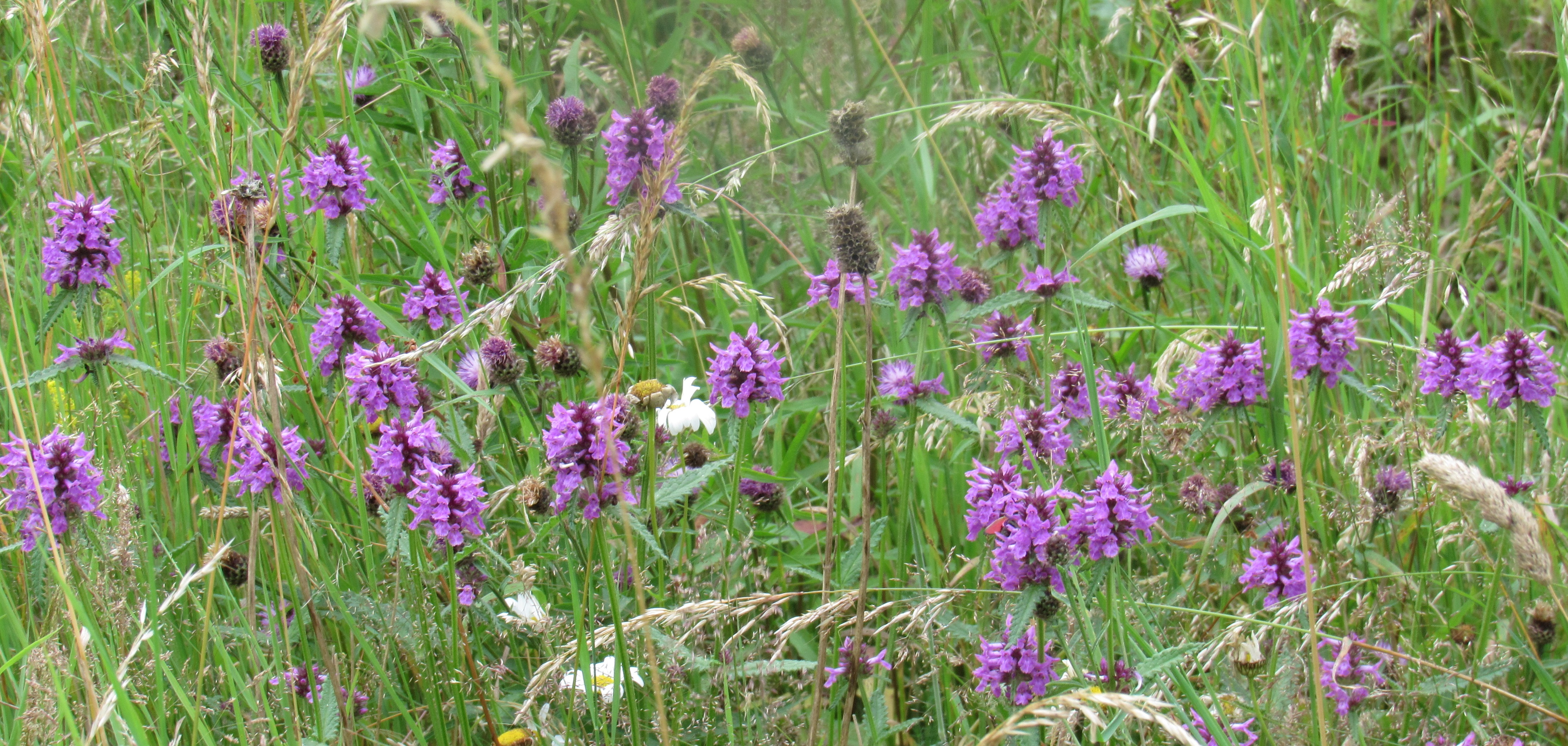 Betony at the Community Woodland (photo: Sue Ashton)
Betony at the Community Woodland (photo: Sue Ashton)
FLOWERING Plants
Sowing the Site
When the Community Woodland site was first adopted, it was sprayed with herbicide, leaving bare ground which was then re-seeded in October 2008 with a meadow mix containing four fine grasses (Common bent, Crested dogstail, Red fescue and Slender creeping red fescue) and twenty-four wild flower species (sown in varying percentages): Betony, Bird’s-foot trefoil, Bladder campion, Common knapweed, Common sorrel, Cowslip, Field scabious, Hedge bedstraw, Hoary plantain, Lady's bedstraw, Meadow buttercup, Meadowsweet, Musk mallow, Oxeye daisy, Ragged robin, Red campion, Rough hawkbit, Salad burnet, Selfheal, Tufted vetch, Wild basil, Wild carrot, Yarrow and Yellow rattle.
While some of the original species have been crowded out by the grasses or more dominant species, other species have arrived by themselves. We also sowed more seed when we created the Butterfly and Bee Banks (see Projects section).
FLOWERING PLANTS RECORDED MONTH BY MONTH
By Liz Gibbs
Photos by Liz Gibbs unless otherwise credited
AUGUST 2024
Brimstone butterfly nectaring on Betony at the woodland (photo: Sue Ashton)
List of 26 flowering plants recorded at the woodland in August 2024:
Betony (Betonica officinalis), Bramble (Rubus ulmifolius), Bristly ox-tongue (Picris echiodes), Buddleia (Buddleia, garden escape), Common hawkbit (Leontodon taraxacoides), Creeping buttercup (Ranunculus repens), Creeping thistle (Cirsium arvense), Dandelion (Taraxacum officinale), Dog daisy (Leucanthemum vulgare), Fleabane (Pulicaria dysenterica), Hedge parsley (Torilis japonica), Hogweed (Heracleum sphondylium), Knapweed (Centaurea nigra), Lesser bindweed (Convolvulus arvensis), Lesser spearwort (Ranunculus flammula), Marjoram (Origanum vulgare), Pickerel weed (Pontederia cordata), Purple loosestrife (Lythrum salicaria), Ragwort (Senecio jacobaea), Red campion (Silene doica), Scabious (Scabiosa columbaria), Spear thistle (Cirsium vulgare), Stinging nettle (Urtica doica), Sweet briar (Rosa rubiginosa), White clover (Trifolium repens), Yarrow (Achillea millefolium).
JULY 2024
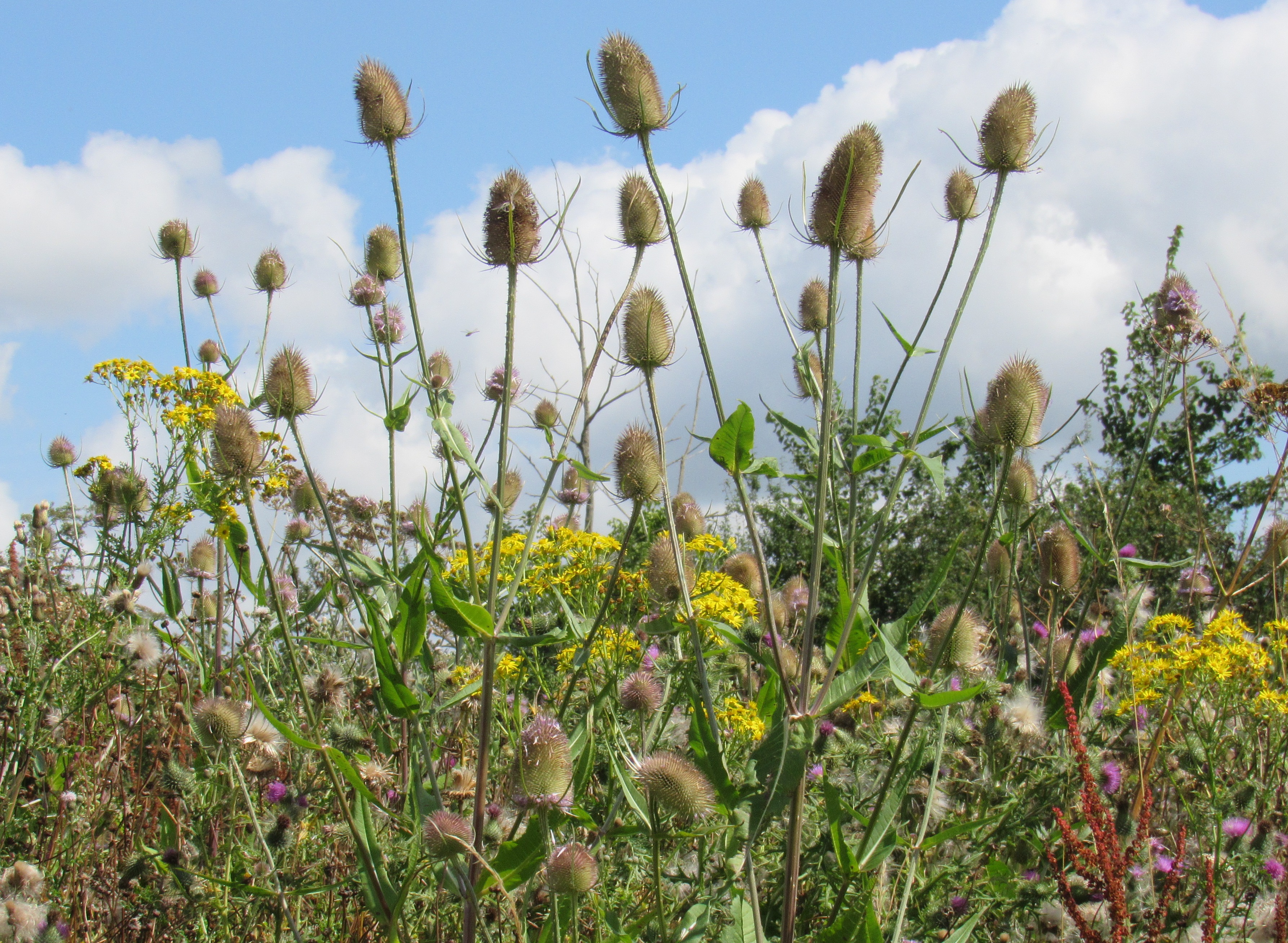 Teasel (Dipsacus fullonum) on the butterfly bank, July 2024 (photo: Sue Ashton)
Teasel (Dipsacus fullonum) on the butterfly bank, July 2024 (photo: Sue Ashton)
List of 41 flowering plants recorded at the woodland in July 2024:
Agrimony (Agrimonia eupatoria), Betony (Betonica officinalis), Bindweed (Calystegia sepium), Bramble (Rubus ulmifolius), Bristly ox-tongue (Picris echiodes), Buddleia (Buddleia, garden escape), Common mallow (Malva sylvestris), Creeping buttercup (Ranunculus repens), Creeping soft grass (Holcus mollis), Dandelion (Taraxacum officinale), Dog daisy (Leucanthemum vulgare), Fringed water lily (Nymphoides peltata), Groundsel (Senecio vulgaris), Hedge bedstraw (Galium mollugo), Hedge parsley (Torilis japonica), Knapweed (Centaurea nigra), Lady’s bedstraw (Galium verum), Lesser bindweed (Convolvulus arvensis), Marjoram (Origanum vulgare), Meadow foxtail (Alopecurus pratensis), Meadowsweet (Filipendula ulmaria), Pendulous sedge (Carex pendula), Pickerel weed (Pontederia cordata), Purple loosestrife (Lythrum salicaria), Ragwort (Senecio jacobaea), Red campion (Silene doica), Ribwort plantain (Plantago lanceolata), Rosa rugosa (Rosa rugosa), Scabious (Scabiosa columbaria), Self-heal (Prunella vulgaris), Small-flowered cranesbill (Geranium pusillum), Soft hawk’s-beard (Crepis mollis), Spear thistle (Cirsium vulgare), Spreading hedge parsley (Torilis arvensis), Stinging nettle (Urtica doica), Sweet briar (Rosa rubiginosa), Teasel (Dipsacus fullonum), Timothy grass (Phleum pratense), Tufted vetch (Viccia cracca), White clover (Trifolium repens), Yarrow (Achillea millefolium).
JUNE 2024
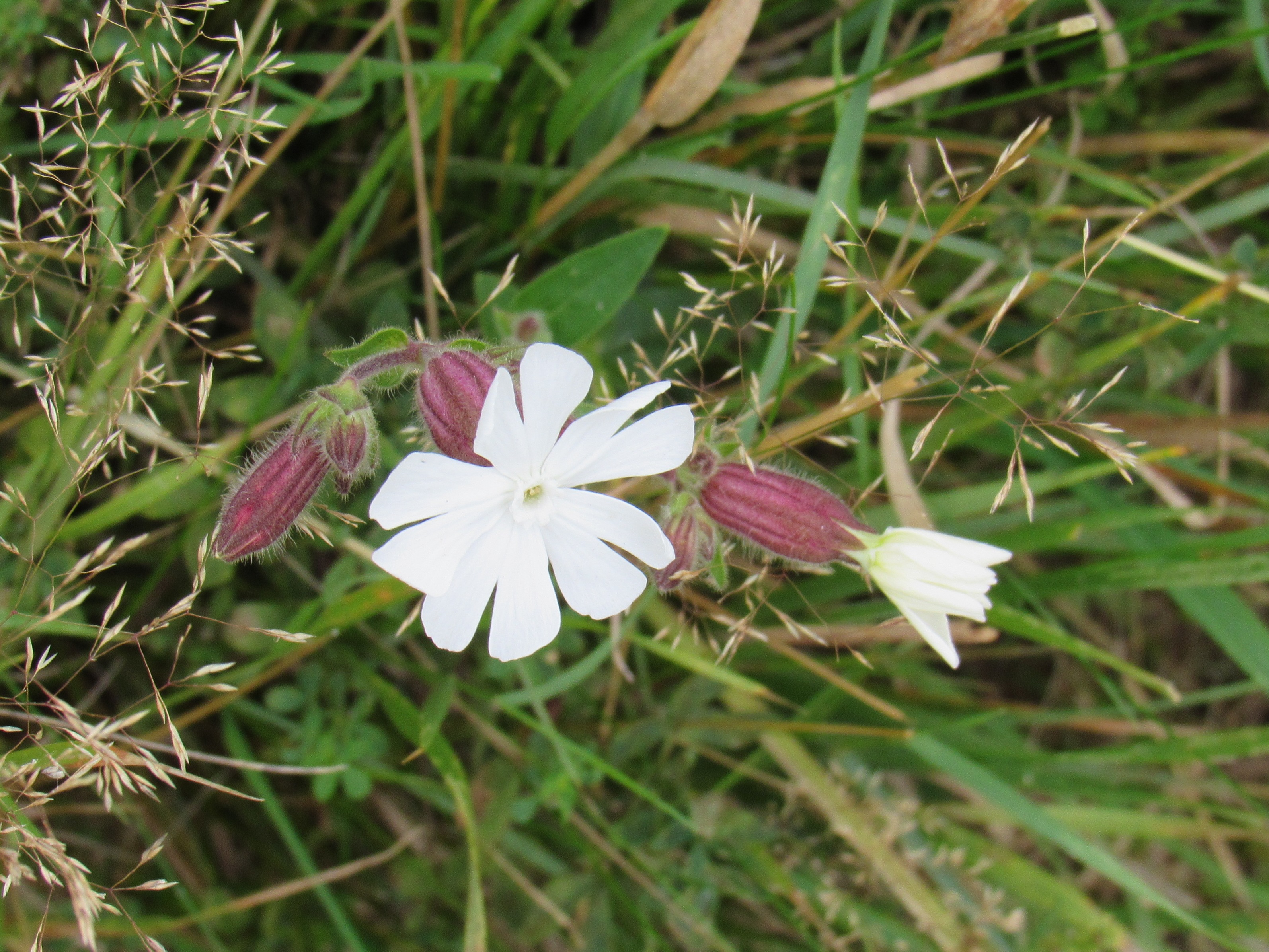 White campion (Silene alba) at the woodland (photo: Sue Ashton)
White campion (Silene alba) at the woodland (photo: Sue Ashton)
List of 44 flowering plants recorded at the woodland in June 2024:
Bindweed (Calystegia sepium), Bird’s-foot trefoil (Lotus corniculatus), Bladder campion (Silene vulgaris), Bramble (Rubus ulmifolius), Buddleia (Buddleia davidii, garden escape), Cock’s foot (Dactylis glomerata), Common mallow (Malva sylvestris), Couch grass (Agropyron repens), Creeping buttercup (Ranunculus repens), Daisy (Bellis perennis), Dog daisy (Leucanthemum vulgare), Dog rose (Rosa canina), Fringed water lily (Nymphoides peltata), Ground ivy (Glechoma hederacea), Hedge bedstraw (Galium mollugo), Hedge parsley (Torilis japonica), Herb Robert (Geranium Robertianum), Hieracium (Hieracium perpropinquum), Hogweed (Heracleum sphondylium), Honeysuckle (Lonicera periclymenum), Knapweed (Centaurea nigra), Lady’s bedstraw (Galium verum), Lesser herb Robert (Geranium purpureum), Lesser stitchwort (Stellaria graminea), Marsh woundwort (Stachys palustris), Meadow buttercup (Ranunculus acris), Meadow crane’s-bill (Geranium pratense), Meadow foxtail (Alopecurus pratensis), Meadowsweet (Filipendula ulmaria), Mrs Robb’s bonnet (Euphorbia Robbiae), Oat grass (Arrehenatherum elatus), Purple loosestrife (Lythrum salicaria), Ragwort (Senecio jacobaea), Red campion (Silene doica), Scabious (Scabiosa columbaria), Smooth hawkbit (Leontodon autumnalis), Sorrel (Rumex fruticosis), Spear thistle (Cirsium vulgare), Stinging nettle (Urtica doica), Teasel (Dipsacus fullonum), Timothy grass (Phleum pratense), White campion (Silene alba), White clover (Trifolium repens), Yarrow (Achillea millefolium).
MAY 2024
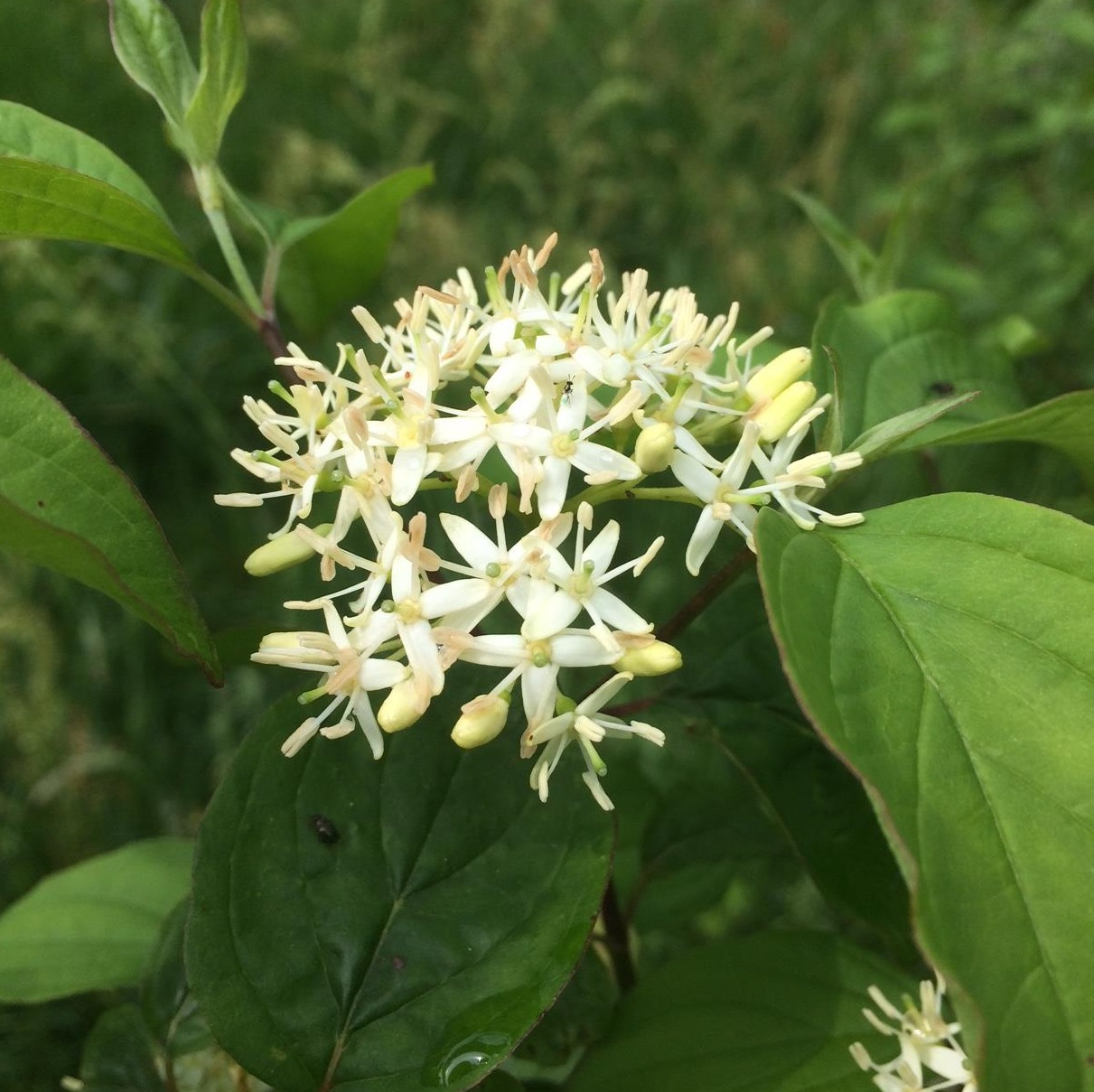 Dogwood flowering at the woodland in May
Dogwood flowering at the woodland in May
List of 34 flowering plants recorded at the woodland in May 2024:
Bladder campion (Silene vulgaris), Bramble (Rubus ulmifolius), Chickweed (Stellaria media), Cock’s foot (Dactylis glomerata), Comfrey (Symphytum officinale), Common cat’s-ear (Hypochoeris radicata), Cow parsley (Anthriscus sylvestris), Creeping buttercup (Ranunculus repens), Cut-leaved cranesbill (Geranium dissectum), Daisy (Bellis perennis), Dandelion (Taraxacum officinale), Dog daisy (Leucanthemum vulgare), Dog rose (Rosa canina), Dogwood (Thelycrania sanguinea), Forget-me-not (Myosotis sylvatica, garden escape), Ground ivy (Glechoma hederacea), Hedge parsley (Torilis japonica), Herb Robert (Geranium Robertianum), Hogweed (Heracleum sphondylium), Meadow buttercup (Ranunculus acris), Meadow cranesbill (Geranium pratense), Meadow foxtail (Alopecurus pratense), Meadow grass (Poa trivialis), Red campion (Silene doica), Self-heal (Prunella vulgaris), Stinging nettle (Urtica doica), Trailing rose (Rosa arvensis), Tufted vetch (Viccia cracca), Velvet bent (Agrostis canina), Water buttercup (Ranunculus linguagrandiflora), White campion (Silene alba), White clover (Trifolium repens), Wood woundwort (Stachys sylvatica), Yarrow (Achillea millefolium).
APRIL 2024
Hawthorn blossom at the woodland in April (photo: Sue Ashton)
List of 26 flowering plants recorded at the woodland in April 2024:
Apple (Malus domestica, cultivated), Bramble (Rubus ulmifolius), Buckthorn (Rhamnus cathartica), Clematis (Clematis montana, garden escape), Comfrey (Symphytum officinale), Cow parsley (Anthriscus sylvestris), Cowslip (Primula veris), Creeping buttercup (Ranunculus repens), Cut-leaved cranesbill (Geranium dissectum), Dandelion (Taraxacum officinale), Dog rose (Rosa canina), Elderflower (Sambucus nigra), Ground ivy (Glechoma hederacea), Guelder rose (Viburnum opulus), Hawthorn (Crategos monogyna), Herb Robert (Geranium Robertianum), Hogweed (Heracleum sphondylium), Lesser stitchwort (Stellaria graminea), Meadow buttercup (Ranunculus acris), Red campion (Silene doica), Rosa rugosa (Rosa rugosa), Rowan (Sorbus acuparia), Tufted vetch (Viccia cracca), Whitebeam (Sorbus aria), Wood garlic (Allium ursinum), Yellow flag iris (Iris pseudacorus).
MARCH 2024
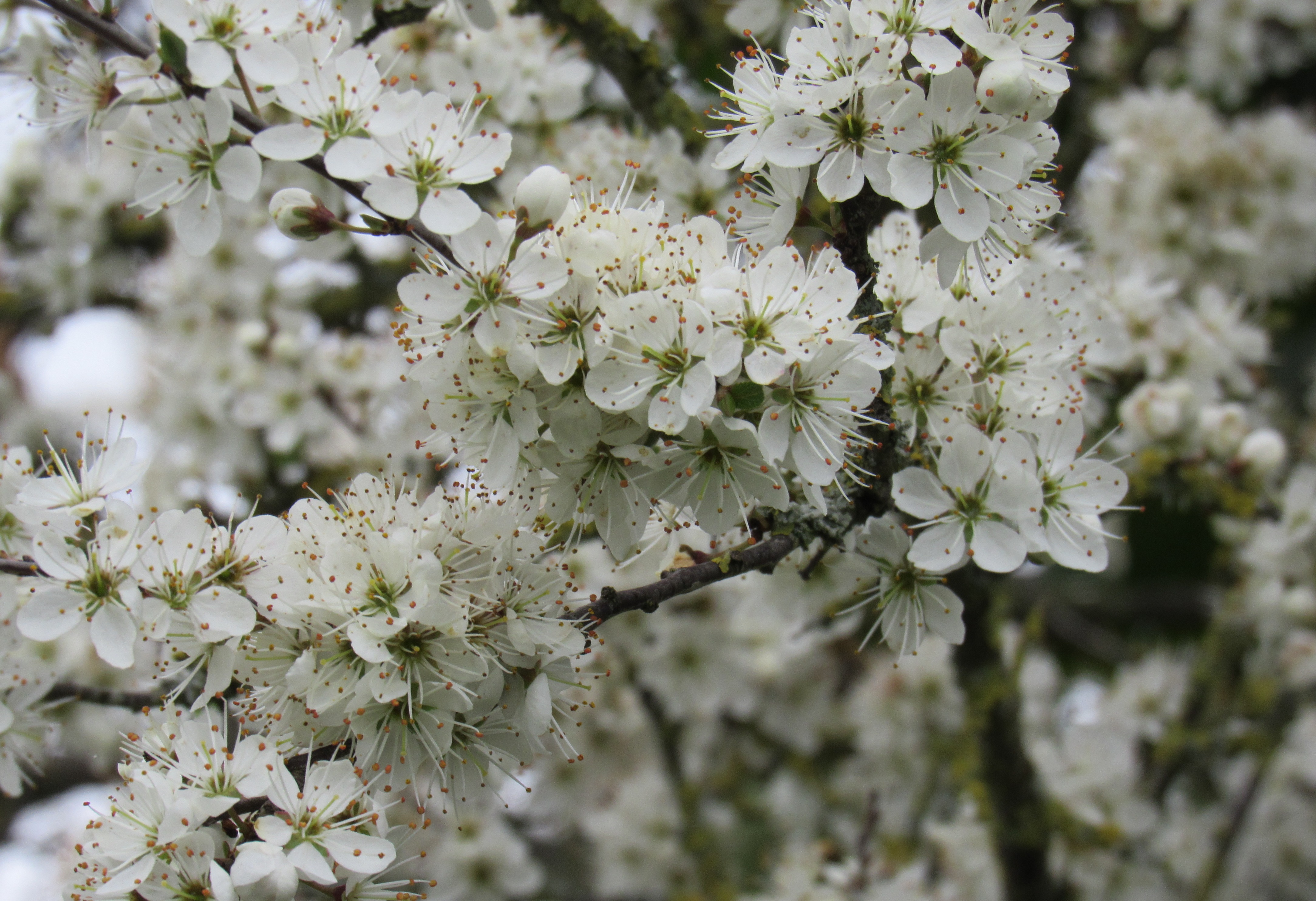 Blackthorn blossom at the woodland in March (photo: Sue Ashton)
Blackthorn blossom at the woodland in March (photo: Sue Ashton)
List of 23 flowering plants recorded at the woodland in March 2024:
Blackthorn (Prunus spinosa), Bluebell (Endymion non-scriptus), Comfrey (Symphytum officinale), Cow parsley (Anthriscus sylvestris), Cowslip (Primula veris), Daisy (Bellis perennis), Dandelion (Taraxacum officinale), Germander speedwell (Veronica chamaedrys), Ground ivy (Glechoma hederacea), Hawthorn (Crataegus monogyna), Herb Robert (Geranium Robertianum), Groundsel (Senecio vulgaris), Lesser celandine (Ficaria verna), Meadow buttercup (Ranunculus acris), Mrs Robb’s bonnet (Euphorbia Robbiae), Primrose (Primula vulgaris), Purple deadnettle (Lamium purpureum), Red campion (Silene doica), Viburnum (Viburnum tinus), Vinca (Vinca major), Wild cherry (Prunus avium), Wild garlic (Gallium ursinum), Winter windflower (Anemone blanda).
AUGUST 2023
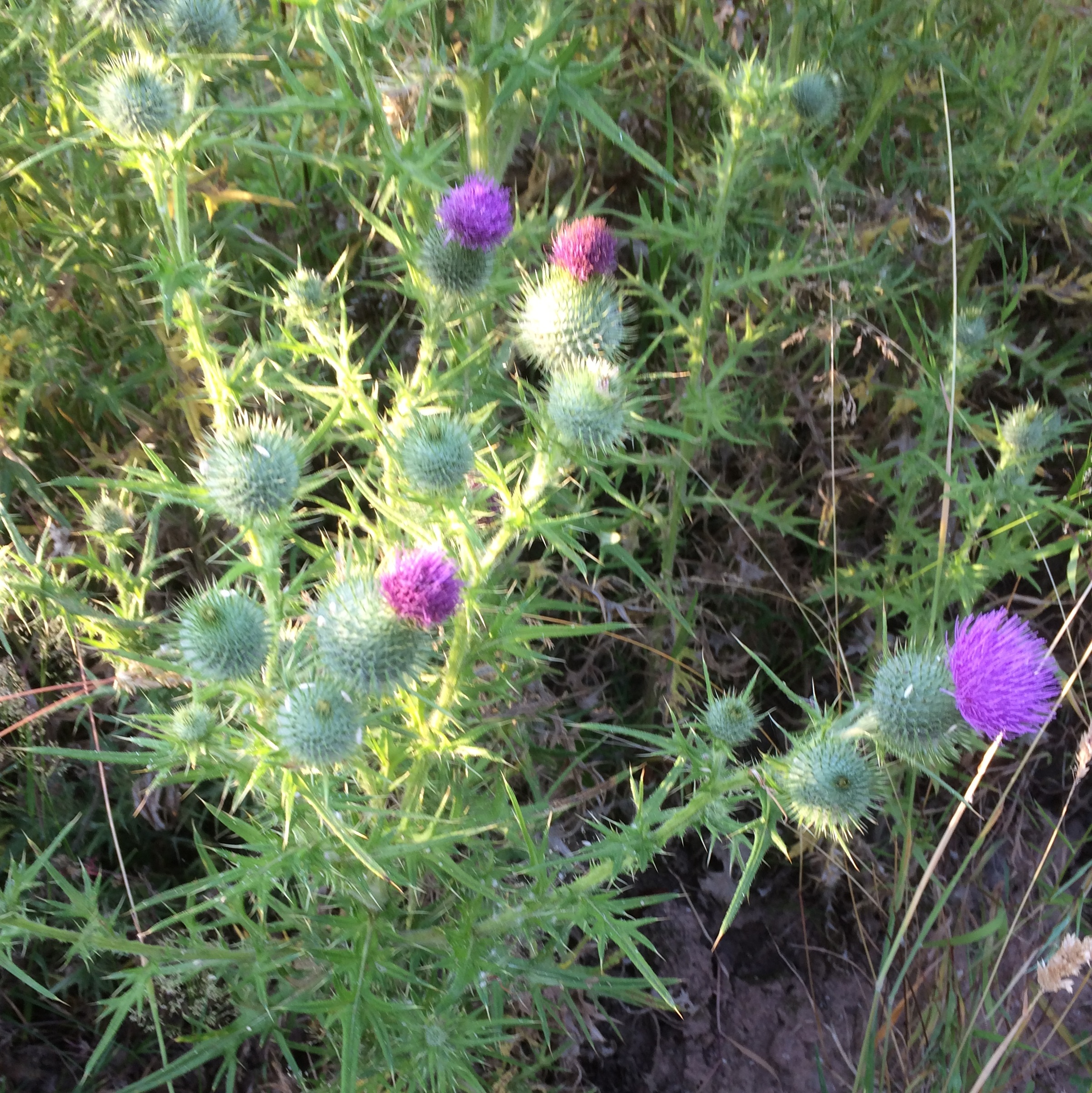 Spear thistle (Cirsium vulgare) at the woodland
Spear thistle (Cirsium vulgare) at the woodland
List of 32 flowering plants recorded at the woodland in August 2023:
Betony (Betonica officinalis), Bindweed (Calystegia sepium), Bird’s-foot trefoil (Lotus corniculatus), Bramble (Rubus ulmifolius), Bulrush/Reedmace (Typha latifolia), Corn sowthistle (Sonchus arvensis), Couch grass (Agropyron repens), Daisy (Bellis perennis), Dandelion (Taraxacum officinale), Dog daisy (Leucanthemum vulgare), Feverfew (Chrysanthemum parthenium), Fringed water lily (Nymphoides peltata), Herb Robert (Geranium Robertianum), Knapweed (Centaurea nigra), Lady’s bedstraw (Galium verum), Long smooth-headed poppy (Papaver dubium), Marjoram (Origanum vulgare), Meadow buttercup (Ranunculus acris), Mullein (Verbascum thapsus), Pickerel weed (Pontederia cordata), Prickly sowthistle (Sonchus asper), Purple loosestrife (Lythrum salicaria), Ragwort (Senecio jacobaea), Red campion (Silene doica), Scabious (Scabiosa columbaria), Smooth hawkbit (Leontodon autumnalis), Spear thistle (Cirsium vulgare), Thin runner willow herb (Epilobium obscurum), Timothy grass (Phleum pratense), Tufted vetch (Viccia cracca), White campion (Silene alba), Yarrow (Achillea millefolium).
JULY 2023
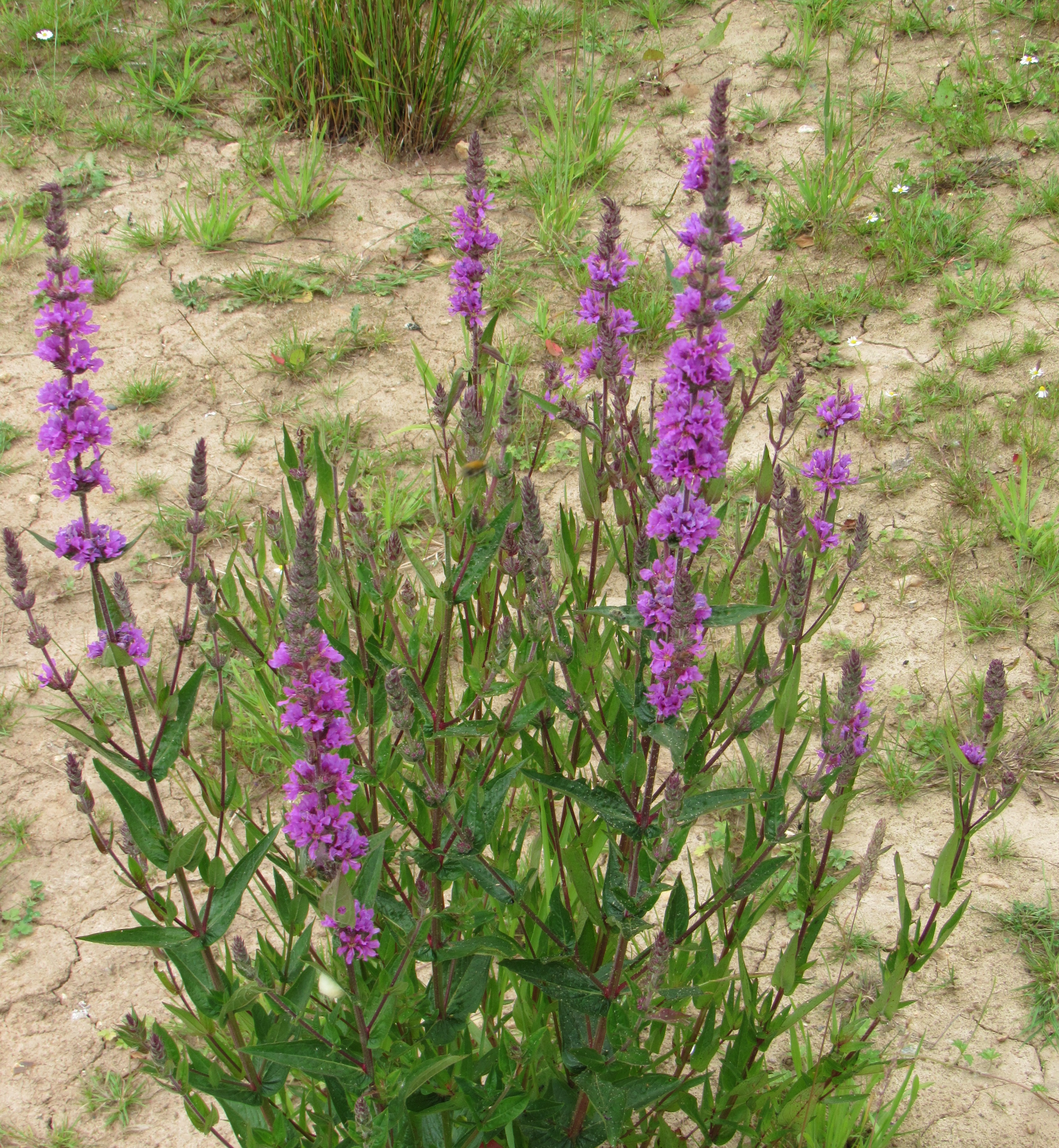 Purple loosestrife (Lythrum salicaria) by the pond (photo: Sue Ashton)
Purple loosestrife (Lythrum salicaria) by the pond (photo: Sue Ashton)
List of 36 flowering plants recorded at the woodland in July 2023:
Betony (Betonica officinalis), Bindweed (Calystegia sepium), Bird’s-foot trefoil (Lotus corniculatus), Bramble (Rubus ulmifolius), Buddleia (Buddleia davidii), Bulrush/Reedmace (Typha latifolia), Chickweed (Stellaria media), Corn chamomile (Anthemis arvensis), Corn marigold (Glebionis segetum), Creeping buttercup (Ranunculus repens), Creeping thistle (Cirsium arvense), Daisy (Bellis perennis), Fleawort (Senecio cineraria), Fringed water lily (Nymphoides peltata), Herb Robert (Geranium Robertianum), Knapweed (Centaurea nigra), Lady’s bedstraw (Galium verum), Lesser bindweed (Convolvulus arvensis), Long smooth-headed poppy (Papaver dubium), Marjoram (Origanum vulgare), Meadow barley (Hordeum secalinum), Meadow buttercup (Ranunculus acris), Meadow foxtail (Alopecurus pratensis), Mullein (Verbascum thapsus), Pickerel weed (Pontederia cordata), Purple loosestrife (Lythrum salicaria), Ragwort (Senecio jacobaea), Red campion (Silene doica), Scabious (Scabiosa columbaria), Soft hawk’s-beard (Crepis mollis), Spear thistle (Cirsium vulgare), Thin runner willow herb? (Epilobium obscurum), Tufted vetch (Viccia cracca), White campion (Silene alba), White clover (Trifolium repens), Yarrow (Achillea millefolium).
JUNE 2023
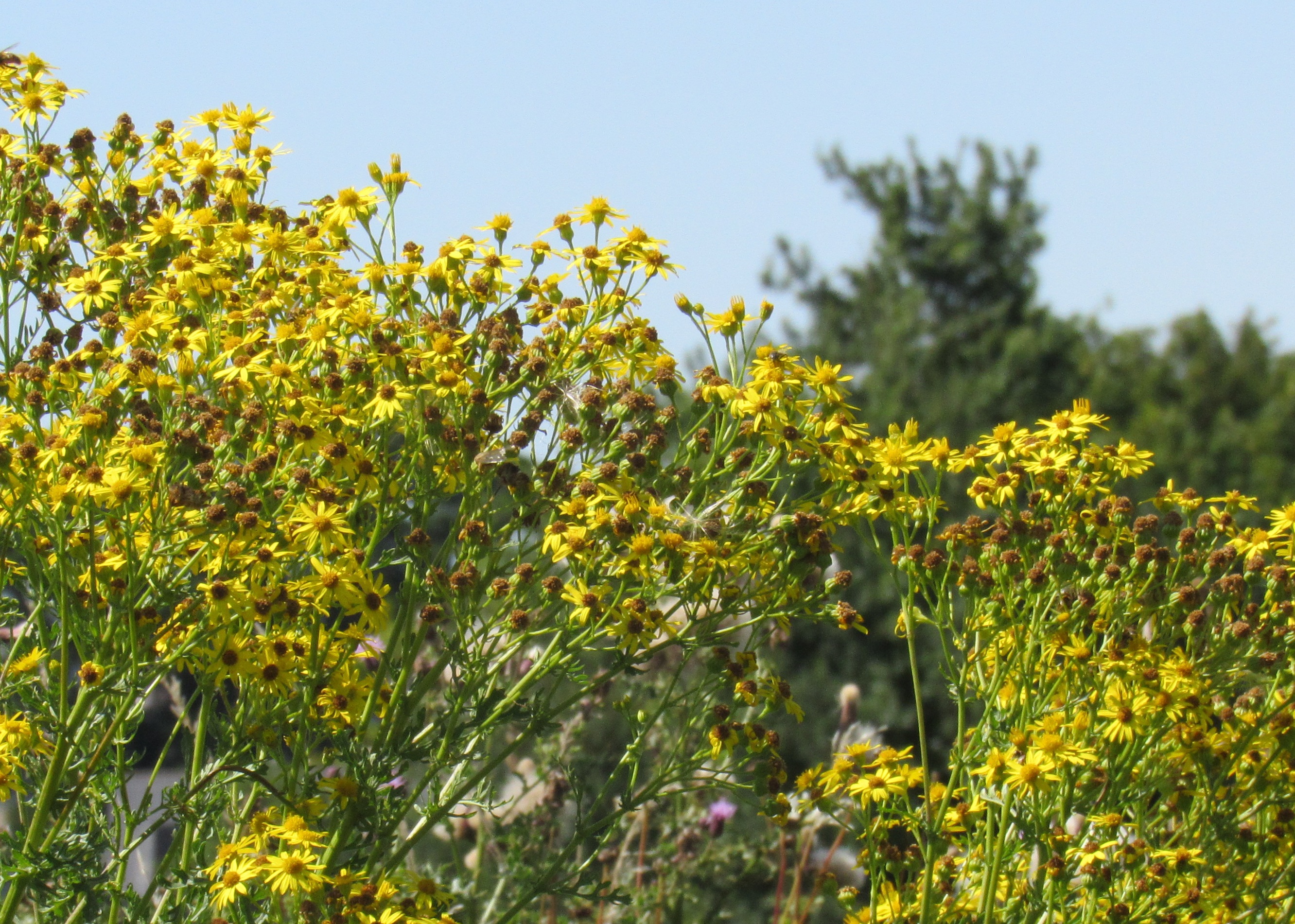 Ragwort (Senecio jacobaea) at the woodland (photo: Sue Ashton)
Ragwort (Senecio jacobaea) at the woodland (photo: Sue Ashton)
List of 51 flowering plants recorded at the woodland in June 2023:
Agrimony (Agrimonia eupatoria), Betony (Betonica officinalis), Bindweed (Calystegia sepium), Bird’s-foot trefoil (Lotus corniculatus), Bramble (Rubus ulmifolius), Buddleia (Buddleia davidii), Bulrush/Reedmace (Typha latifolia), Cock’s foot (Dactylis glomerata), Comfrey (Symphytum officinale), Common mallow (Malva sylvestris), Couch grass (Agropyron repens), Creeping buttercup (Ranunculus repens), Creeping thistle (Cirsium arvense), Daisy (Bellis perennis), Dog daisy (Leucanthemum vulgare), Dog rose (Rosa canina), Feverfew (Chrysanthemum parthenium), Hedge bedstraw (Galium mollugo), Hedge parsley (Torilis japonica), Hogweed (Heracleum sphondylium), Honeysuckle (Lonicera periclymenum), Horehound (Ballota nigra), Knapweed (Centaurea nigra), Lady’s bedstraw (Galium verum), Lesser bindweed (Convolvulus arvensis), Long smooth-headed poppy (Papaver dubium), Meadow buttercup (Ranunculus acris), Meadow crane’s-bill (Geranium pratense), Meadow foxtail (Alopecurus pratensis), Meadowsweet (Filipendula ulmaria), Mullein (Verbascum thapsus), Musk mallow (Malva moschata), Oat grass (Arrehenatherum elatus), Privet (Ligustrum vulgare), Purple loosestrife (Lythrum salicaria), Ragwort (Senecio jacobaea), Red campion (Silene doica), Rosa rugosa (Rosa rugosa), Rye grass (Lolium perenne), Scabious (Scabiosa columbaria), Small-flowered crane’s-bill (Geranium pusillum), Soft hawk’s-beard (Crepis mollis), Spear thistle (Cirsium vulgare), Stinging nettle (Urtica doica), Teasel (Dipsacus fullonum), Timothy grass (Phleum pratense), Trailing rose (Rosa arvensis), Tufted vetch (Viccia cracca), White campion (Silene alba), White clover (Trifolium repens), Yarrow (Achillea millefolium).
MAY 2023
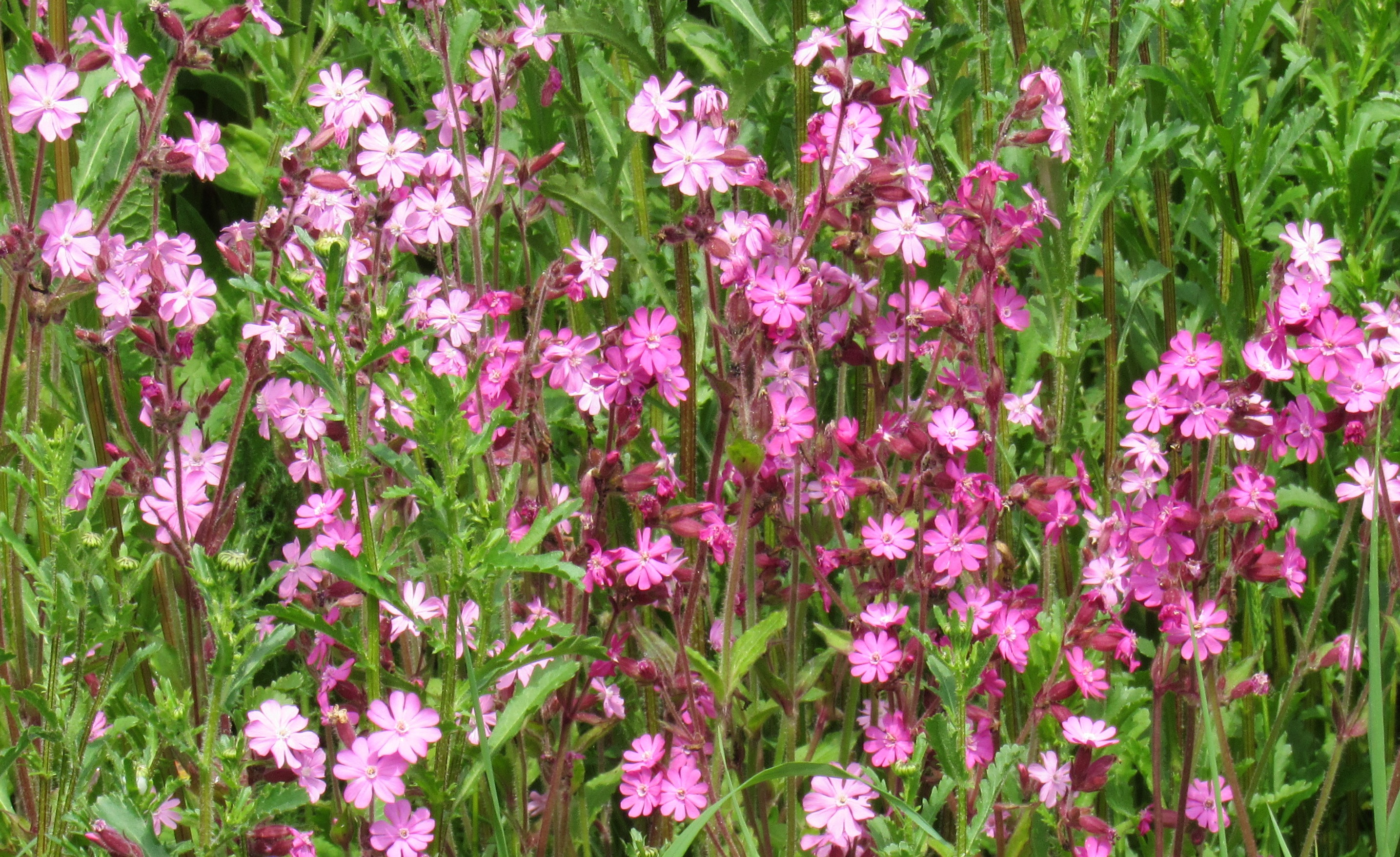 Red campion (Silene doica) at the woodland in May (photo: Sue Ashton)
Red campion (Silene doica) at the woodland in May (photo: Sue Ashton)
List of 46 flowering plants recorded at the woodland in May 2023:
Bird’s-foot trefoil (Lotus corniculatus), Bladder campion (Silene vulgaris), Buckthorn (Rhamnus cathartica), Chickweed (Stellaria media), Cleavers (Galium aparine), Clematis (Clematis montana, garden escape), Cock’s foot (Dactylis glomerata), Comfrey (Symphytum officinale), Couch grass (Agropyron repens), Cow parsley (Anthriscus sylvestris), Creeping buttercup (Ranunculus repens), Cut-leaved cranesbill (Geranium dissectum), Daisy (Bellis perennis), Dandelion (Taraxacum officinale), Dog daisy (Leucanthemum vulgare), Dog rose (Rosa canina), Dogwood (Thelycrania sanguinea), Elder (Sambucus nigra), Ground ivy (Glechoma hederacea), Hawthorn (Crataegus monogyna), Hedge parsley (Torilis japonica), Herb Robert (Geranium Robertianum), Hogweed (Heracleum sphondylium), Horse chestnut (Aesculus hippocastranum), Knapweed (Centaurea nigra), Lesser stitchwort (Stellaria graminea), Lesser yellow trefoil (Trifolium dubium), Long smooth-headed poppy (Papaver dubium), Meadow buttercup (Ranunculus acris), Meadow fescue (Festuca pratensis), Meadow foxtail (Alopecurus pratense), Meadow grass (Poa trivialis), Mrs Robb’s bonnet (Euphorbia Robbiae), Oat grass (Arrehenatherum elatus), Purple deadnettle (Lamium purpureum), Red campion (Silene doica), Sorrel (Rumex fruticosis), Stinging nettle (Urtica doica), Timothy grass (Phleum pratense), Trailing rose (Rosa arvensis), Tufted vetch (Viccia cracca), Wayfaring tree (Viburnum lantana), Water buttercup (Ranunculus linguagrandiflora), White clover (Trifolium repens), Wood woundwort (Stachys sylvatica), Yellow flag iris (Iris pseudacorus).
APRIL 2023
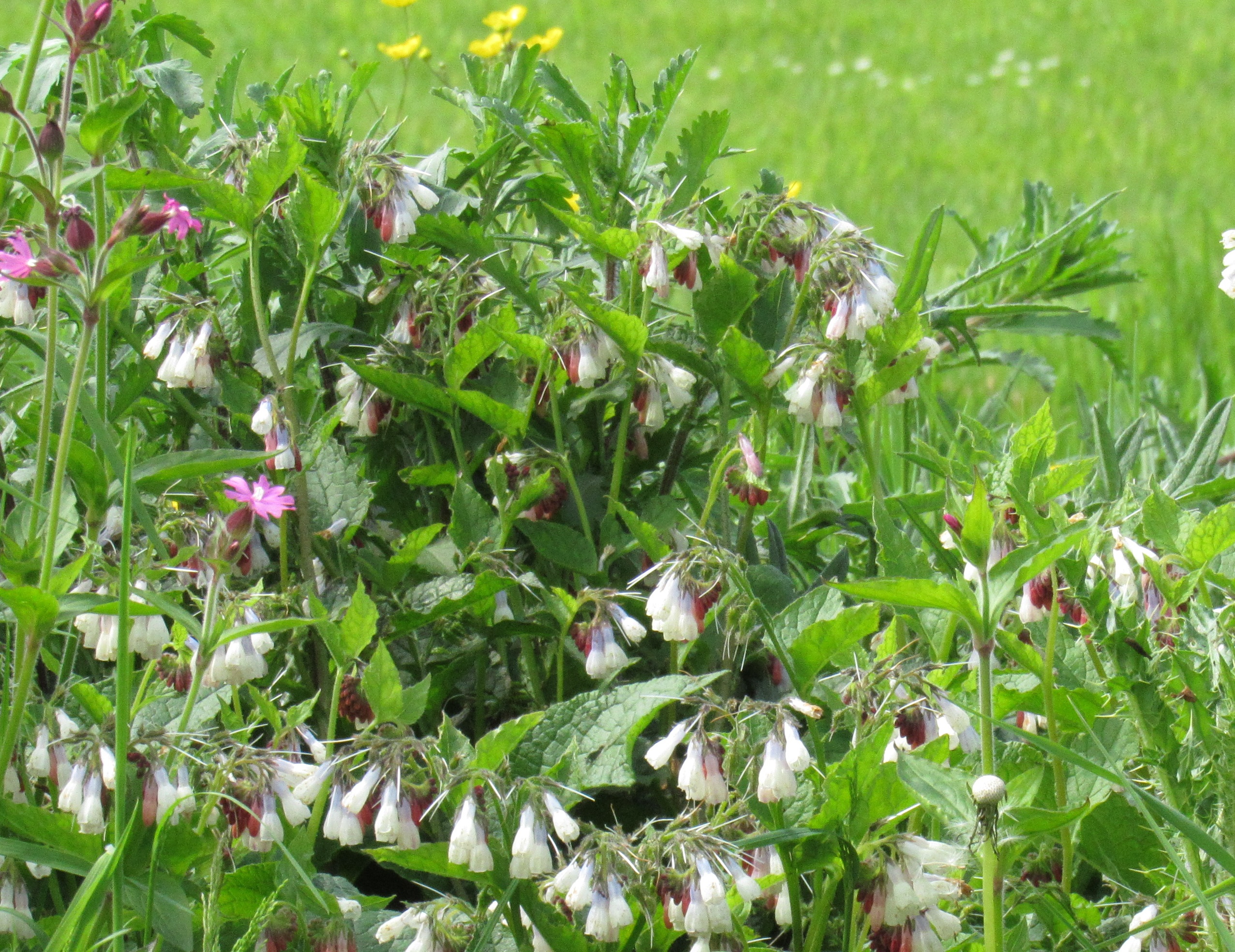 Comfrey (Symphytum officinale) on the butterfly bank (photo: Sue Ashton)
Comfrey (Symphytum officinale) on the butterfly bank (photo: Sue Ashton)
List of 31 flowering plants recorded at the woodland in April 2023:
Alkanet (Anchusa sempervirens), Apple (Malus domestica, cultivated), Arum lily (Arum maculatum), Blackthorn (Prunus spinosa), Bluebell (Endymion non-scriptus), Celandine (Ficaria verna), Cherry (Prunus sp., cultivated), Chickweed (Stellaria media), Clematis (Clematis montana, garden escape), Comfrey (Symphytum officinale), Cow parsley (Anthriscus sylvestris), Cowslip (Primula veris), Cut-leaved cranesbill (Geranium dissectum), Daisy (Bellis perennis), Dandelion (Taraxacum officinale), Forget-me-not (Myosotis sylvatica, garden escape), Garlic mustard (Allialaria petiolata), Ground ivy (Glechoma hederacea), Hawthorn (Crategos monogyna), Herb Robert (Geranium Robertianum), Meadow buttercup (Ranunculus acris), Mrs Robb’s bonnet (Euphorbia Robbiae), Pendulous sedge (Carex pendula), Primrose (Primula vulgaris), Purple deadnettle (Lamium purpureum), Rape (Brassica napus), Red campion (Silene doica), Speedwell (Veronica hederifolia), Timothy grass (Cat’s tail, Phleum pratense), Viburnum (Viburnum tinus), Wood garlic (Allium ursinum).
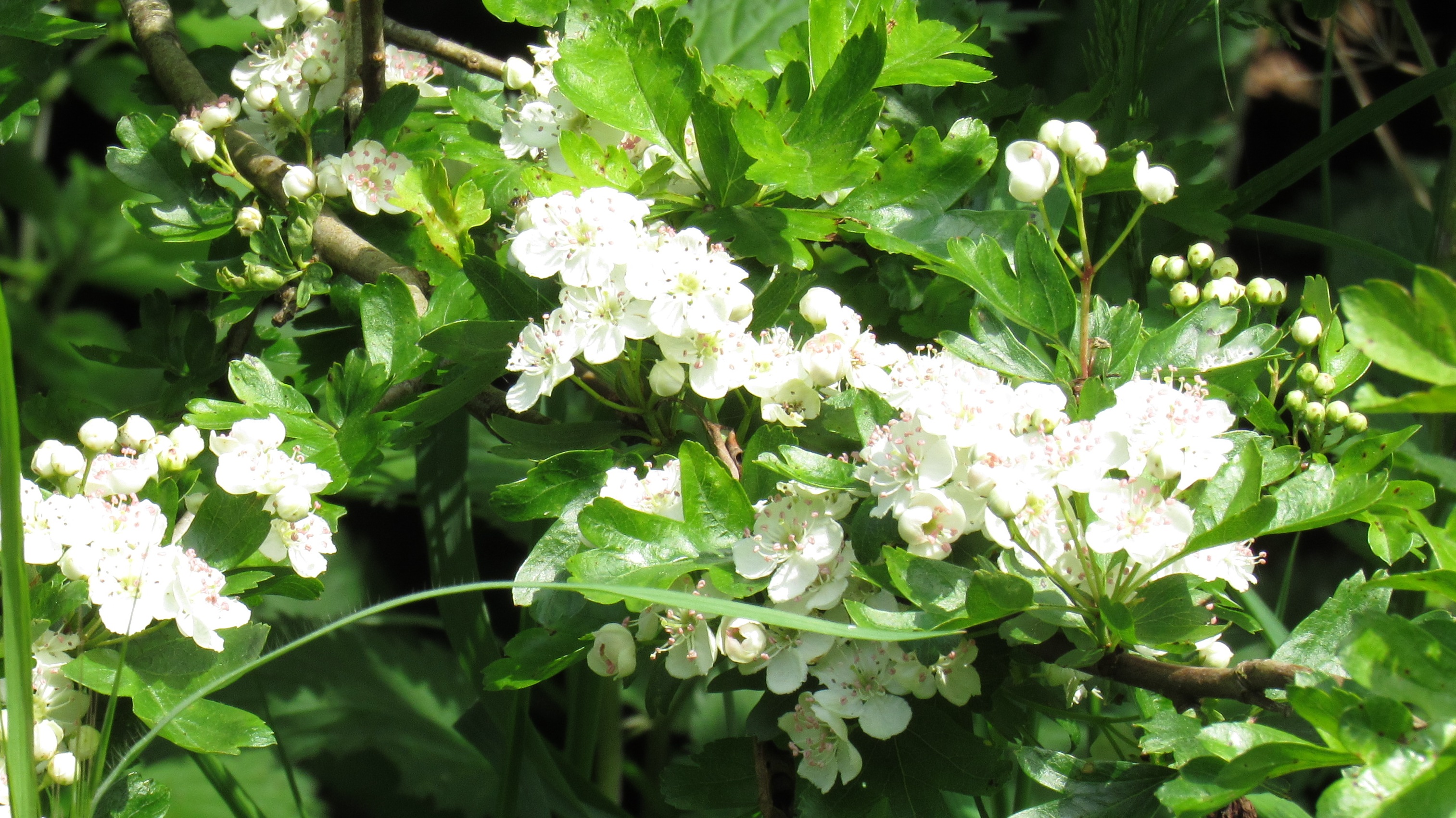 Hawthorn blossom (Crategos monogyna) (photo: Sue Ashton)
Hawthorn blossom (Crategos monogyna) (photo: Sue Ashton)
MARCH 2023
List of 18 flowering plants recorded at the woodland in March 2023:
Blackthorn (Prunus spinosa), Celandine (Ficaria verna), Cherry laurel (Prunus laurocerasus), Clustered mouse ear (Cerastium glomeratum), Comfrey (Symphytum officinale), Cowslip (Primula veris), Daisy (Bellis perennis), Ground ivy (Glechoma hederacea), Hairy bittercress (Cardamine hirsuta), Mrs Robb’s bonnet (Euphorbia Robbiae), Plum (Prunus domestica), Primrose (Primula vulgaris), Purple deadnettle (Lamium purpureum), Speedwell (Veronica fruticans), Viburnum (Viburnum tinus), Vinca, Wayfaring Tree (Viburnum lantana), Wild Garlic/Ramsoms (Allium ursinum).
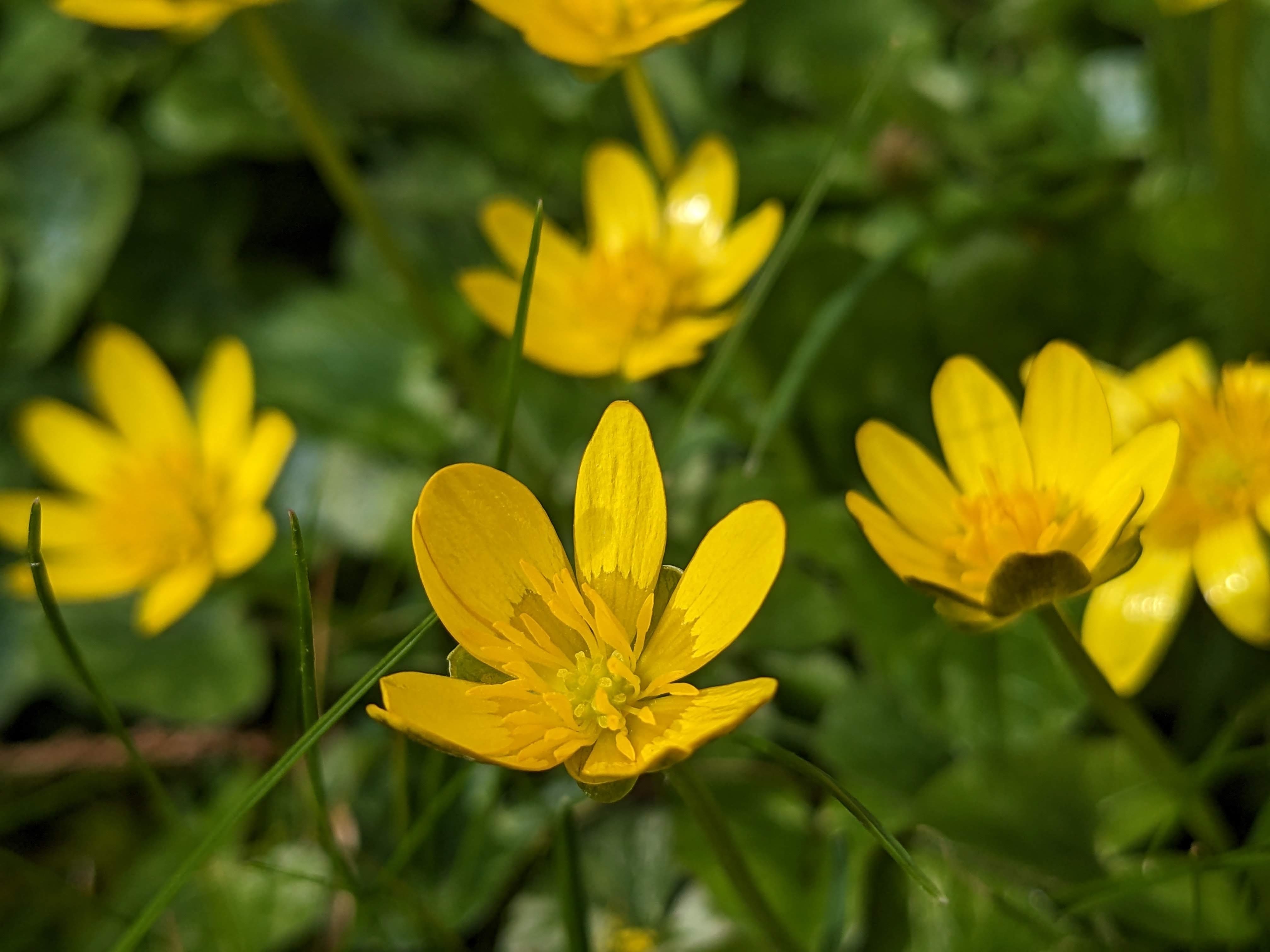 Celandine (Ficaria verna) (photo: George Ashton)
Celandine (Ficaria verna) (photo: George Ashton)
AUGUST 2022
List of 25 flowering plants recorded at the woodland in August 2022:
Bird’s-foot trefoil (Lotus corniculatus), Bristly oxtongue (Picris echiodes), Chickweed (Stellaria media), Common hawkbit (Leontodon taraxacoides), Common red poppy (Papaver rhoeas), Cornflower (Centaurea cyanus), Corn Marigold (Glebionis segetum), Cosmos (garden escape), Creeping thistle (Cirsium arvense), Daisy (Bellis perennis), Dog daisy (Leucanthemum vulgare), Fringed water lily (Nymphoides peltata), Long smooth-headed poppy (Papaver dubium), Mallow (Malva sylvestris), Marjoram (Origanum vulgare), Meadowsweet (Filipendula ulmaria), Pickerel weed (Pontederia cordata), Purple loosestrife (Lythrum salicaria), Red campion (Silene doica), Rosebay willowherb (Epilobium angustifolium), Scabious (Scabiosa columbaria), Tansy (Tanacetum vulgare), Water mint (Mentha aquatica), White clover (Trifolium repens), Yarrow (Achillea millefolium).
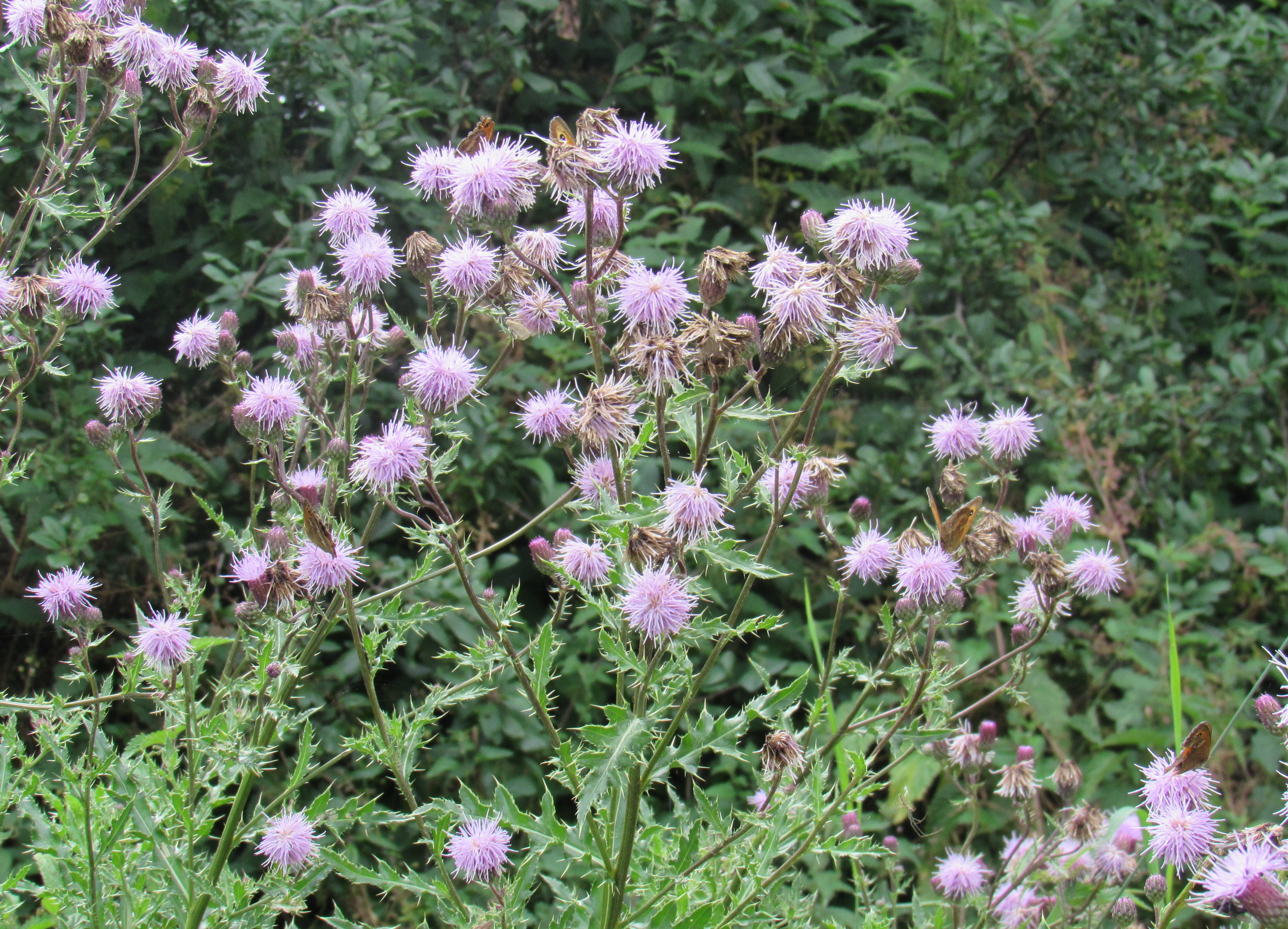 Creeping thistle (Cirsium arvense) (photo: Sue Ashton)
Creeping thistle (Cirsium arvense) (photo: Sue Ashton)
JULY 2022
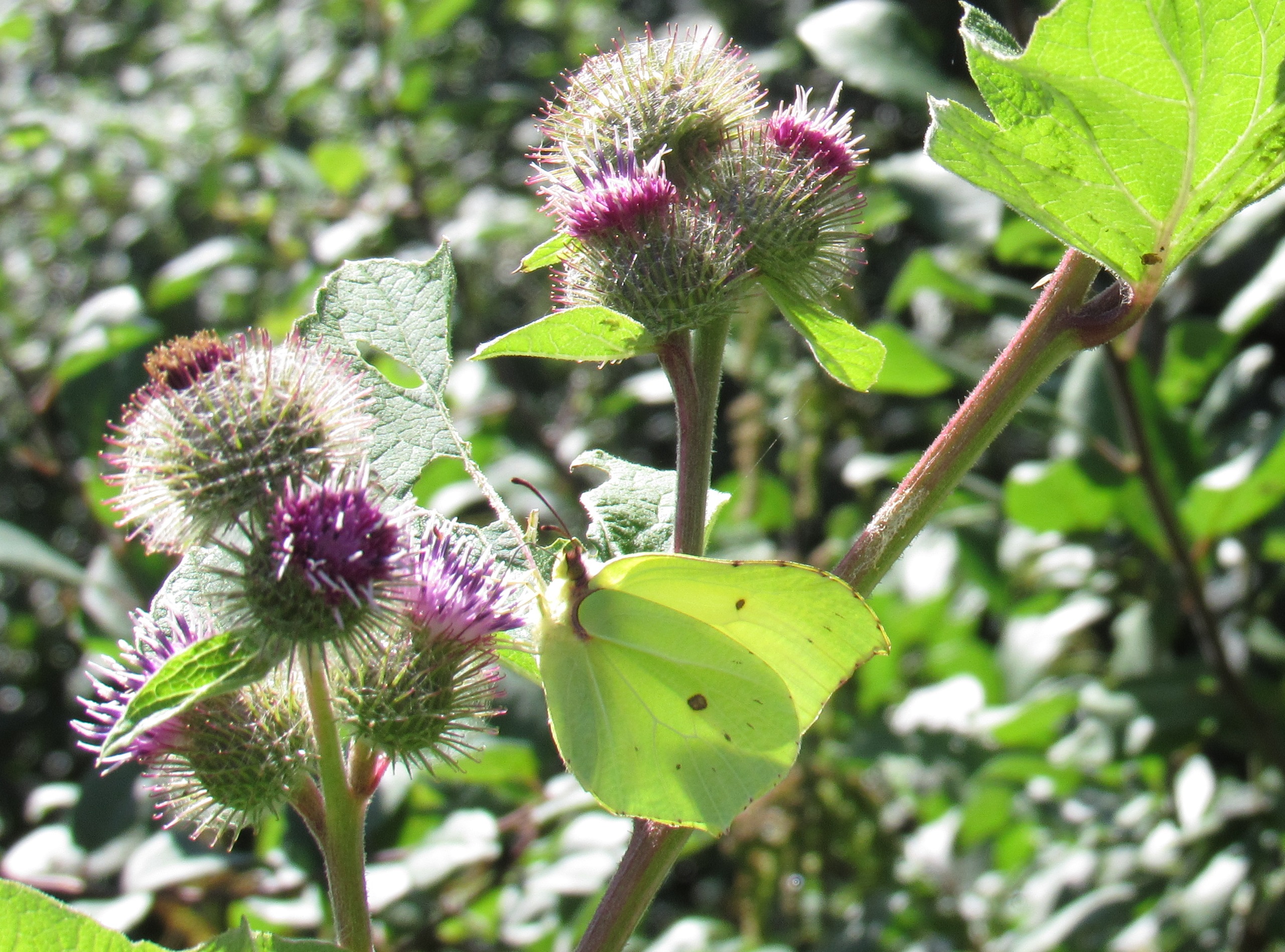 Common burdock (Arctium pubens) (photo: Sue Ashton)
Common burdock (Arctium pubens) (photo: Sue Ashton)
List of 51 flowering plants recorded at the woodland in July 2022:
Agrimony (Agrimonia eupatoria), Betony (Betonica officinalis), Bindweed (Calystegia sepium), Bird’s-foot trefoil (Lotus corniculatus), Borage (Borago officinalis), Bramble (Rubus ulmifolius), Buddleia (Buddleia davidii), Bullrush (Typha latifolia), Comfrey (Symphytum officinale), Common hawkbit (Leontodon taraxacoides), Common burdock (Arctium pubens), Common mallow (Malva sylvestris), Common mullein (Verbascum thapsus), Cornflower (Centaurea cyanus), Corn Marigold (Glebionis segetum), Creeping buttercup (Ranunculus repens), Creeping thistle (Cirsium arvense), Cut-leaved cranesbill (Geranium dissectum), Daisy (Bellis perennis), Dandelion (Taraxacum officinale), Dog daisy (Leucanthemum vulgare), Feverfew (Chrysanthemum parthenium), Field scabious (Knautia arvensis), Fringed water lily (Nymphoides peltata), Greater bellflower (Campanula latifolia), Hedge parsley (Torilis japonica), Horehound (Ballota nigra), Knapweed (Centaurea nigra), Lady’s bedstraw (Galium verum), Lesser yellow trefoil (Trifolium dubium), Long smooth-headed poppy (Papaver dubium), Marjoram (Origanum vulgare), Meadow buttercup (Ranunculus acris), Meadow cranesbill (Geranium pratense), Meadowsweet (Filipendula ulmaria), Phacelia (Phacelia), Pickerel weed (Pontederia cordata), Purple loosestrife (Lythrum salicaria), Ragwort (Senecio jacobaea), Red campion (Silene doica), Red clover (Trifolium pratense), Rosa rugosa (Rosa rugosa), Self-heal (Prunella vulgaris), Spear thistle (Cirsium vulgare), Stinging nettle (Urtica doica), Tufted vetch (Viccia cracca), White campion (Silene alba), White clover (Trifolium repens), White water lily (Nymphaea), Wild chamomile (Matricaria rectutita), Yarrow (Achillea millefolium).
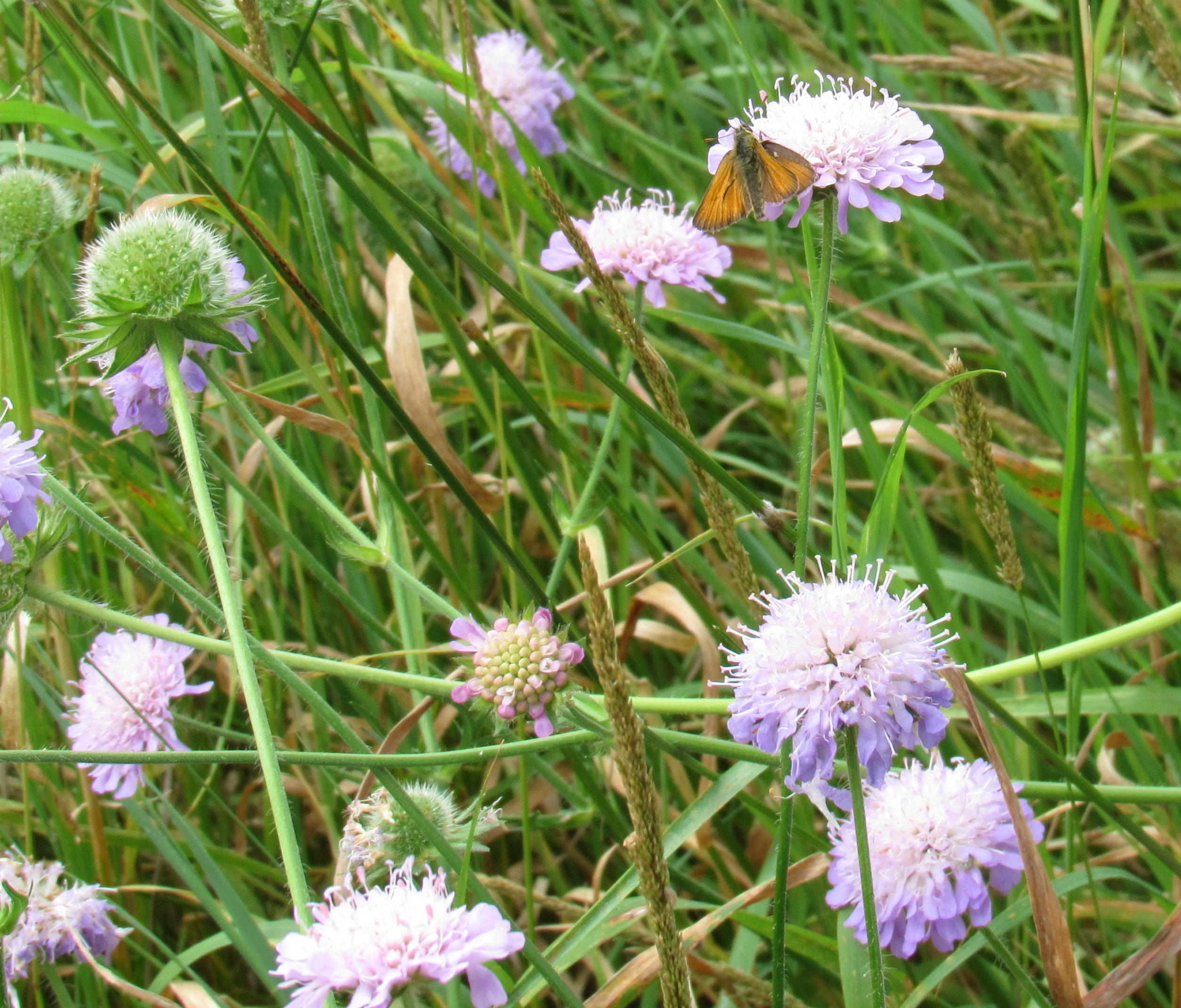 Field scabious (Knautia arvensis) (photo: Sue Ashton)
Field scabious (Knautia arvensis) (photo: Sue Ashton)
JUNE 2022
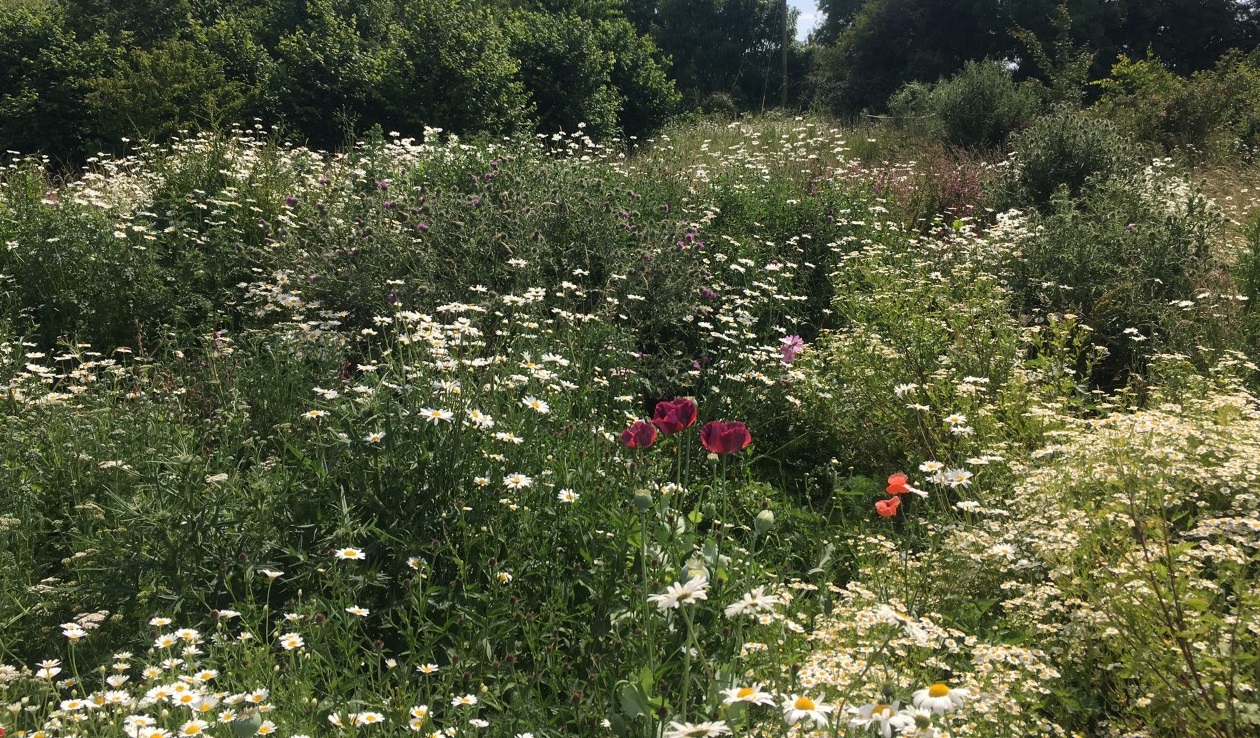 The butterfly bank in June 2022 (photo: Phil Stone)
The butterfly bank in June 2022 (photo: Phil Stone)
List of 45 flowering plants recorded at the woodland in June 2022:
Agrimony (Agrimonia eupatoria), Annual pearlwort (Sagina apetala), Betony (Betonica officinalis), Bindweed (Calystegia sepium), Bird’s-foot trefoil (Lotus corniculatus), Bramble (Rubus ulmifolius), Buddleia (Buddleia davidii), Bulrush/Reedmace (Typha latifolia), Common mallow (Malva sylvestris), Corn cockle (Agrostemma githago), Corn marigold (Glebionis segetum), Creeping buttercup (Ranunculus repens), Creeping thistle (Cirsium arvense), Daisy (Bellis perennis), Dandelion (Taraxacum officinale), Dog rose (Rosa canina), Feverfew (Chrysanthemum parthenium), Greater bellflower (Campanula latifolia), Hedge bedstraw (Galium mollugo), Herb Robert (Geranium robertianum), Hogweed (Heracleum sphondylium), Knapweed (Centaurea nigra), Lady’s bedstraw (Galium verum), Lesser bindweed (Convolvulus arvensis), Lesser yellow trefoil (Trifolium dubium), Long smooth-headed poppy (Papaver dubium), Marjoram (Origanum vulgare), Meadow cranesbill (Geranium pratense), Meadow foxtail (Alopecurus pratensis), Meadowsweet (Filipendula ulmaria), Pickerel weed (Pontederia cordata), Purple deadnettle (Lamium purpureum), Purple loosestrife (Lythrum salicaria), Ragwort (Senecio jacobaea), Rosebay willowherb (Chamaenerion angustifolium), Small scabious (Scabiosa columbaria), Sorrel (Rumex acetosa), Spear thistle (Cirsium vulgare), Stinging nettle (Urtica doica), Stinking chamomile (Anthemis cotula), Tufted vetch (Viccia cracca), White campion (Silene alba), White clover (Trifolium repens), Yarrow (Achillea millefolium).
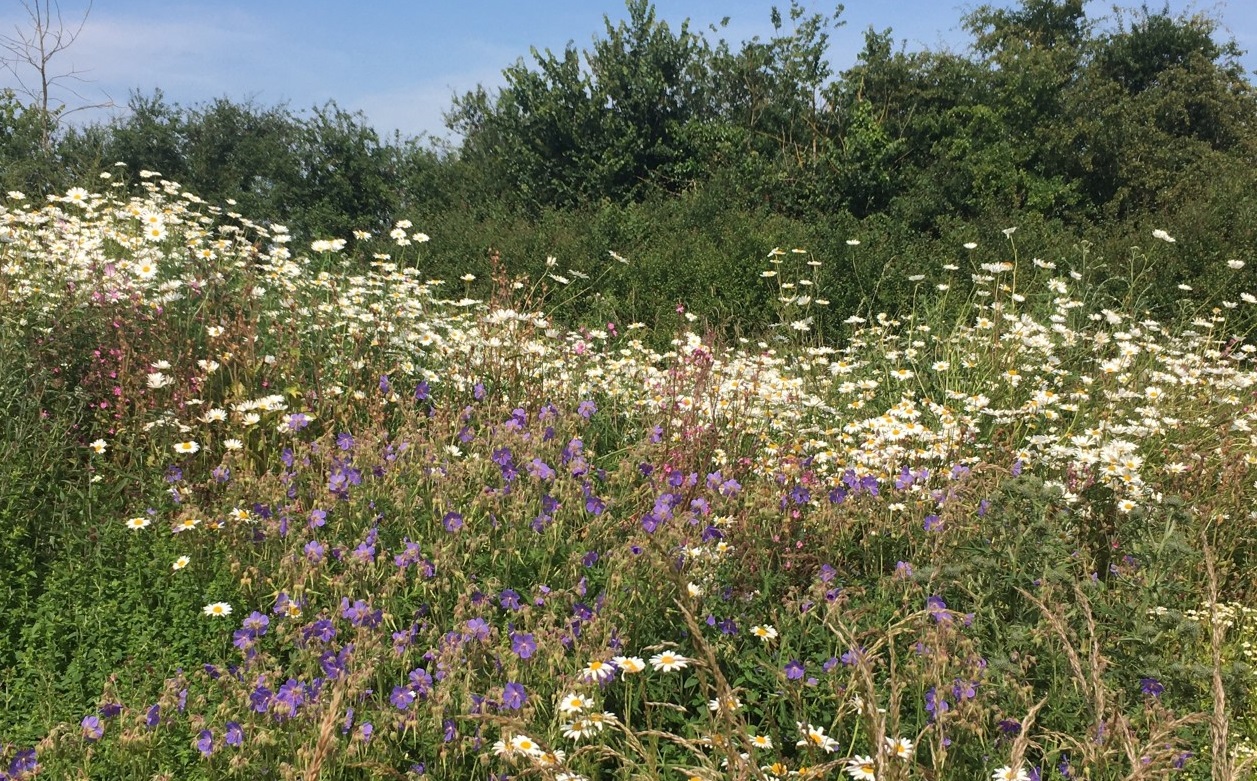 Midsummer butterfly bank 2022 (photo: Phil Stone)
Midsummer butterfly bank 2022 (photo: Phil Stone)
MAY 2022
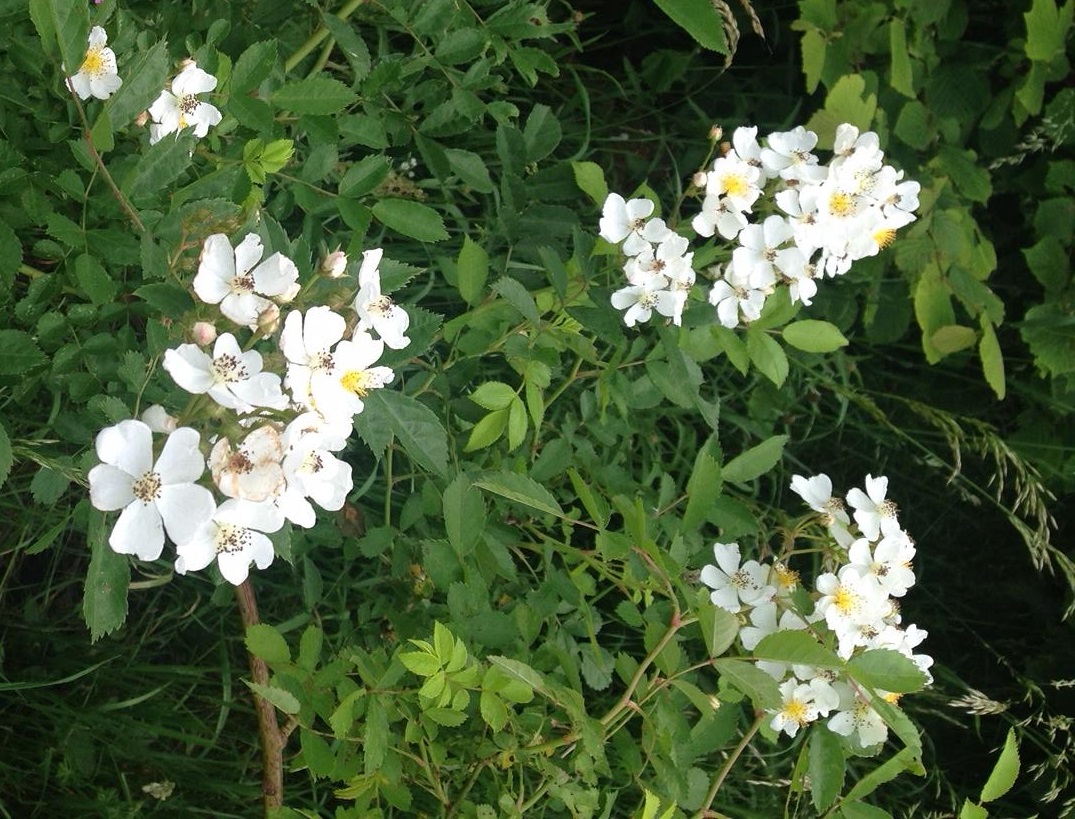 Dog rose (Rosa canina) (photo: Phil Stone)
Dog rose (Rosa canina) (photo: Phil Stone)
List of 40 flowering plants recorded at the woodland in May 2022:
Bird’s-foot trefoil (Lotus corniculatus), Bladder campion (Silene vulgaris), Bramble (Rubus ulmifolius), Buckthorn (Rhamnus cathartica), Cock’s foot (Dactylis glomerata), Comfrey (Symphytum officinale), Cow parsley (Anthriscus sylvestris), Creeping buttercup (Ranunculus repens), Creeping soft grass (Holcus mollis), Creeping thistle (Cirsium arvense), Cut-leaved cranesbill (Geranium dissectum), Daisy (Bellis perennis), Dandelion (Taraxacum officinale), Dog daisy (Leucanthemum vulgare), Dog rose (Rosa canina), Dogwood (Thelycrania sanguinea), Garlic mustard (Alliaria petiolata), Ground ivy (Glechoma hederacea), Guelder rose (Viburnum opulus), Herb Robert (Geranium robertianum), Hogweed (Heracleum sphondylium), Lesser stitchwort (Stellaria graminea), Lesser yellow trefoil (Trifolium dubium), Long smooth-headed poppy (Papaver dubium), Meadow buttercup (Ranunculus acris), Meadow cranesbill (Geranium pratense), Meadow fescue (Festuca pratensis), Meadow foxtail (Alopecurus pratensis), Night-flowering catchfly (Silene noctiflora), Pyracantha (Pyracantha), Red campion (Silene doica), Rosa rugosa (Rosa rugosa), Sorrel (Rumex fruticosis), Spear thistle (Cirsium vulgare), Stinging nettle (Urtica doica), Timothy grass (Phleum pratense),Trailing rose (Rosa arvensis), Tufted vetch (Viccia cracca), White clover (Trifolium repens), Yarrow (Achillea millefolium).
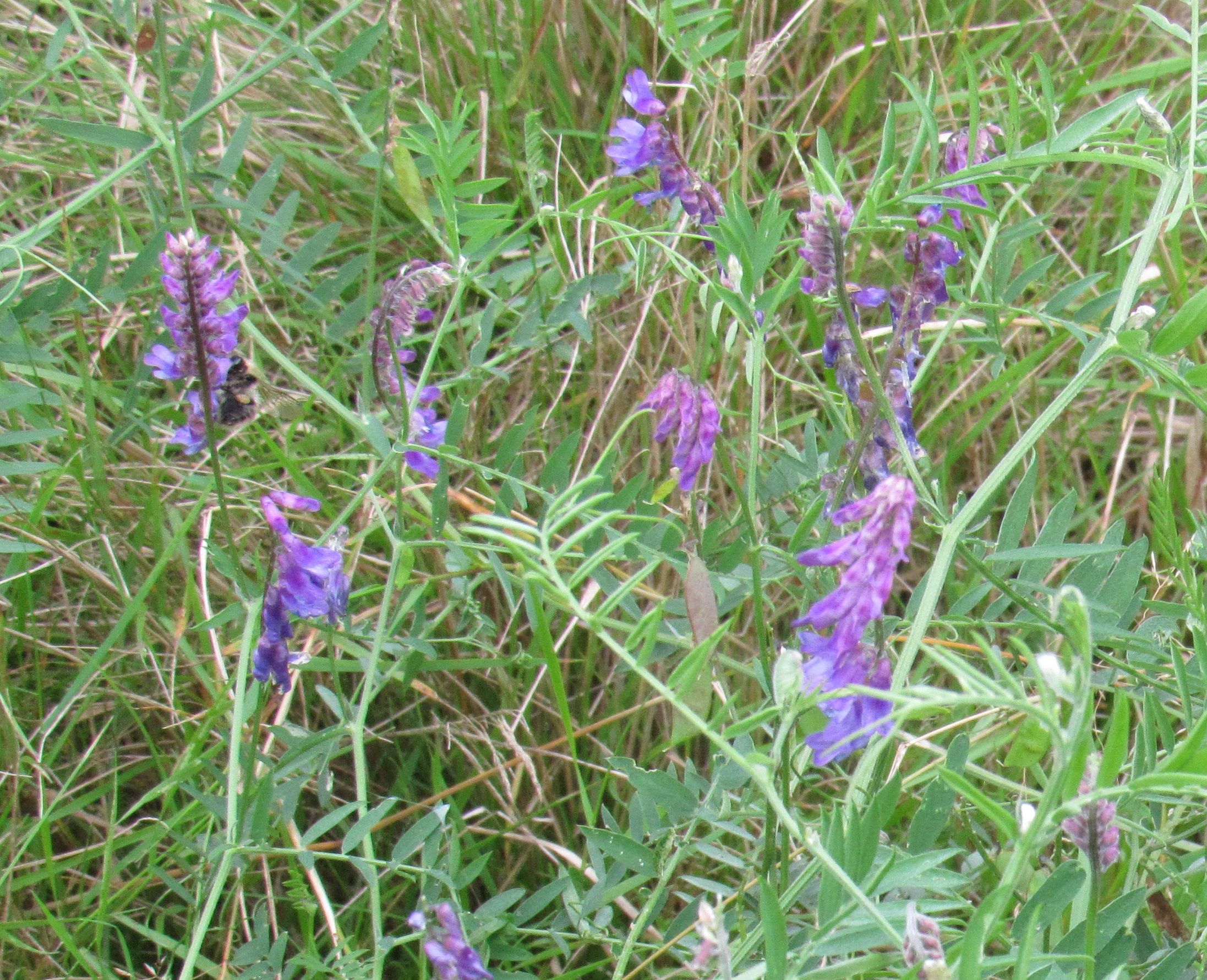 Tufted vetch (Viccia cracca) (photo: Sue Ashton)
Tufted vetch (Viccia cracca) (photo: Sue Ashton)
APRIL 2022
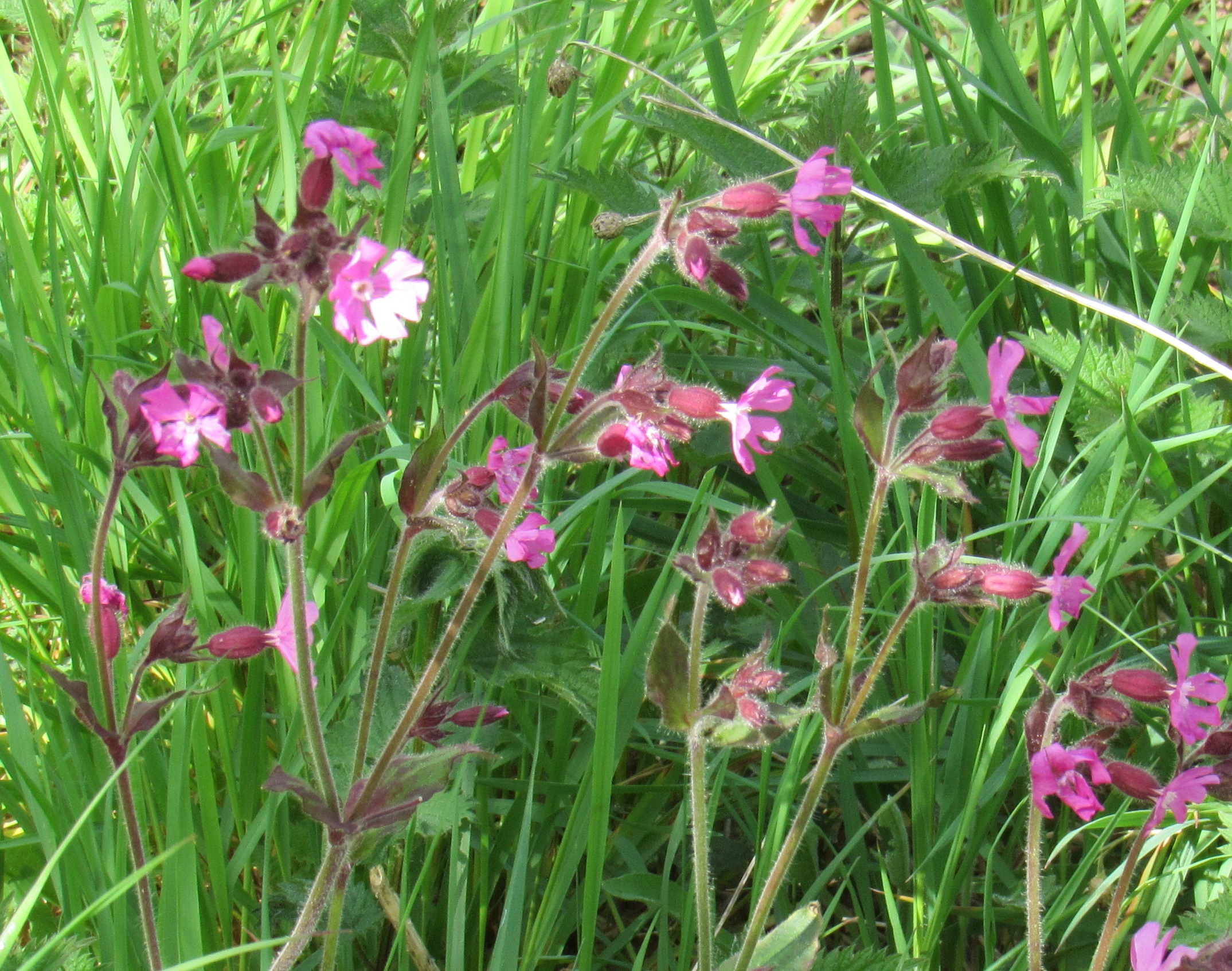 Red campion (Silene doica) (photo: Sue Ashton)
Red campion (Silene doica) (photo: Sue Ashton)
List of 25 flowering plants recorded at the woodland in April 2022:
Bird’s-foot trefoil (Lotus corniculatus), Bluebell (Endymion non-scriptus), Buckthorn (Rhamnus cathartica), Celandine (Ficaria verna), Chickweed (Stellaria media), Comfrey (Symphytum officinale), Common speedwell (Veronica officinalis), Cow parsley (Anthriscus sylvestris), Cowslip (Primula veris), Creeping buttercup (Ranunculus repens), Cut-leaved cranesbill (Geranium dissectum), Daisy (Bellis perennis), Dandelion (Taraxacum officinale), Dog daisy (Chrysanthemum leucanthemum), Dogwood (Thelycrania sanguinea), Ground ivy (Glechoma hederacea), Guelder rose (Viburnum opulus), Herb Robert (Geranium robertianum), Hogweed (Heracleum sphondylium), Lesser stitchwort (Stellaria graminea), Mrs Robb’s bonnet (Euphorbia amygdaloides robbiae), Purple deadnettle (Lamium purpureum), Red campion (Silene doica), Viburnum (Viburnum tinus), Wild garlic (Allium ursinum).
MARCH 2022
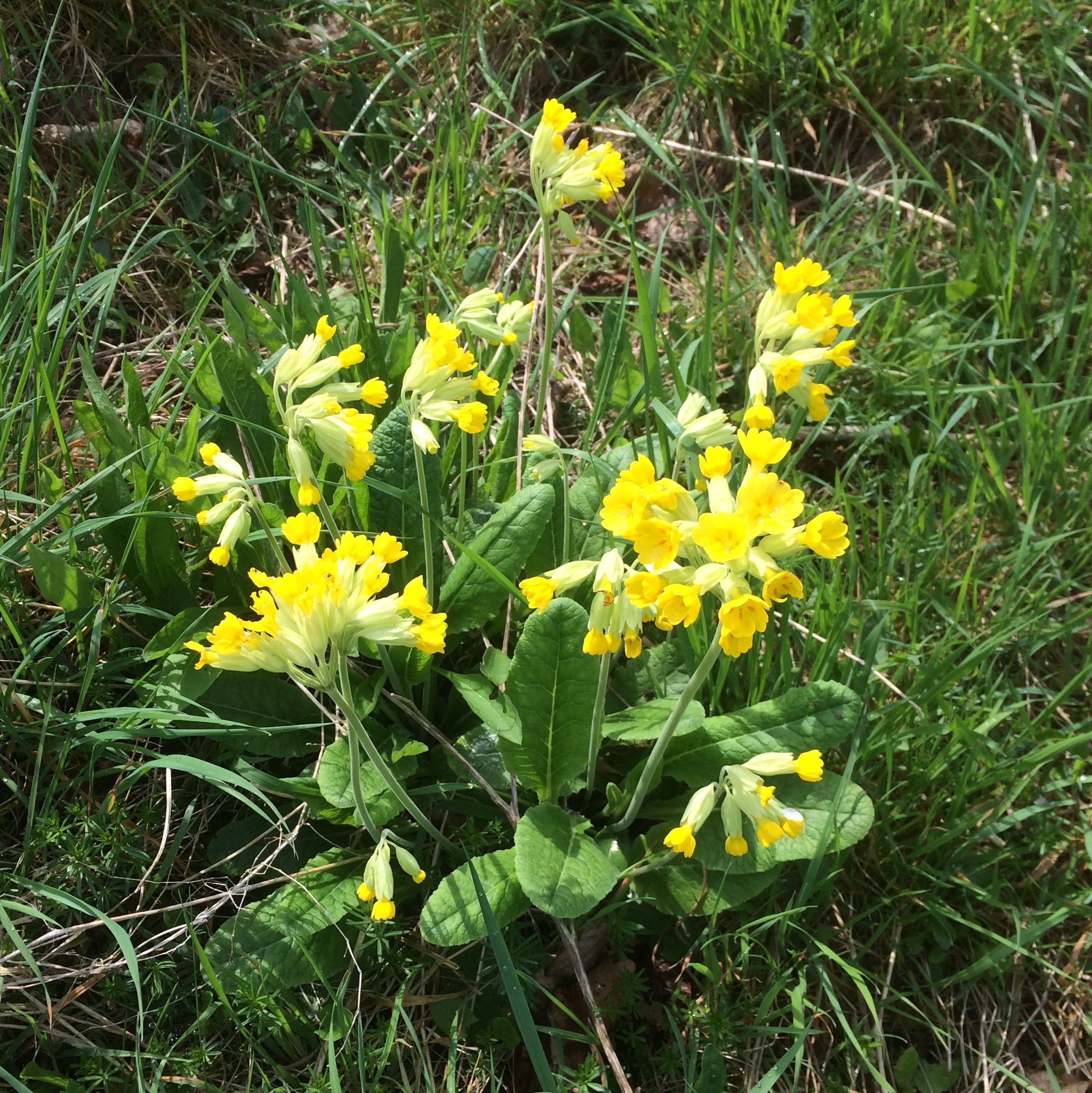 Cowslip (Primula veris) at the woodland
Cowslip (Primula veris) at the woodland
List of 18 flowering plants recorded at the woodland in March 2022:
Arum lily/Lords and ladies (Arum maculatum), Blackthorn (Prunus spinosa), Bluebell (Endymiion non-scriptus), Celandine (Ficaria verna), Cherry laurel (Prunus laurocerasus), Comfrey (Symphytum officinale), Cowslip (Primula veris), Daisy (Bellis perennis), Dandelion (Taraxacum officinale), Ground ivy (Glechoma hederacea), Mrs Robb’s bonnet (Euphorbia amygdaloides robbiae), Plum (Prunus domestica), Primrose (Primula vulgaris), Red campion (Silene doica), Red deadnettle (Lamium purpureum), Viburnum (Viburnum tinus), Wayfaring tree (Viburnum lantana), Wood garlic/Ransoms (Allium ursinum).
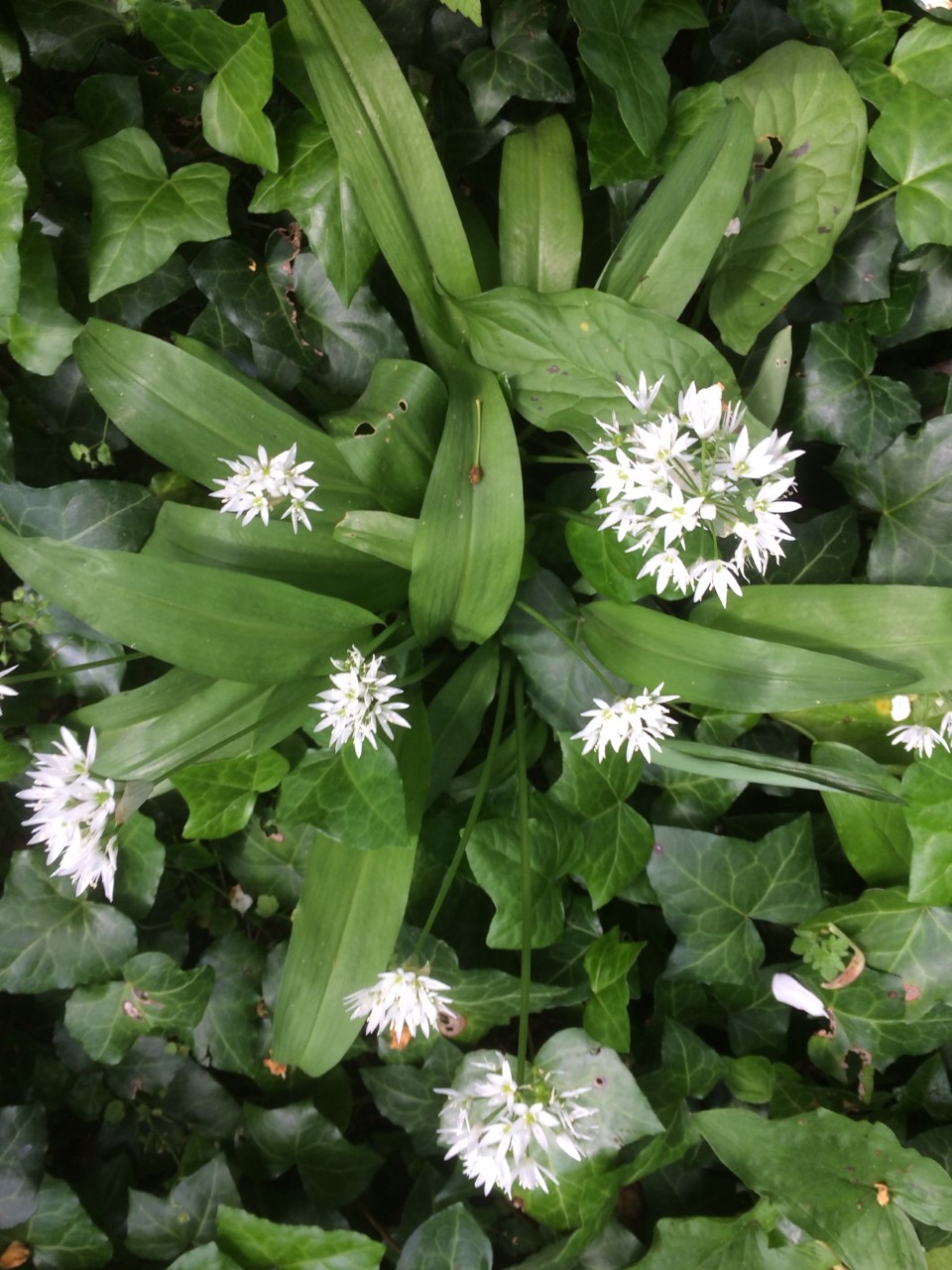 Wood garlic/Ransoms (Allium ursinum)
Wood garlic/Ransoms (Allium ursinum)
AUGUST 2021
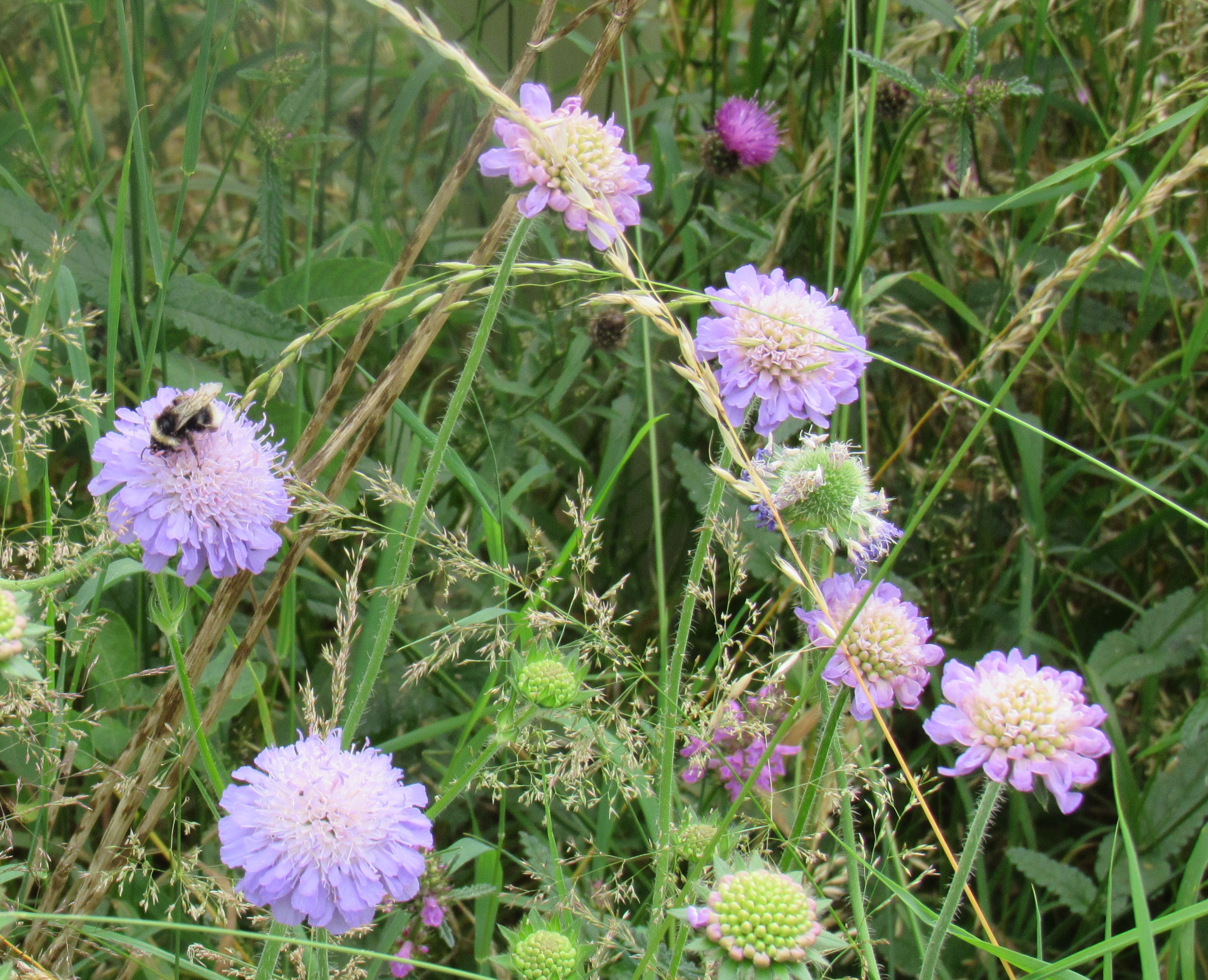 Field scabious (Knautia arvensis) (photo Sue Ashton)
Field scabious (Knautia arvensis) (photo Sue Ashton)
List of 14 flowering plants recorded at the woodland in August 2021:
Bramble (Rubus ulmifolius), Ciliate pearlwort (Sagina ciliata), Common mallow (Malva sylvestris), Cornflower (Centaurea cyanus), Daisy (Bellis perennis), Dog daisy (Chrysanthemum leucanthemum), Field scabious (Knautia arvensis), Hogweed (Heracleum sphondylium), Knapweed (Centaurea nigra), Marjoram (Origanum vulgare), Ragwort (Senecio jacobaea), Smooth hawksbeard (Crepis capillaris), Wild chamomile (Matricaria recutita), Yarrow (Achillea millefolium).
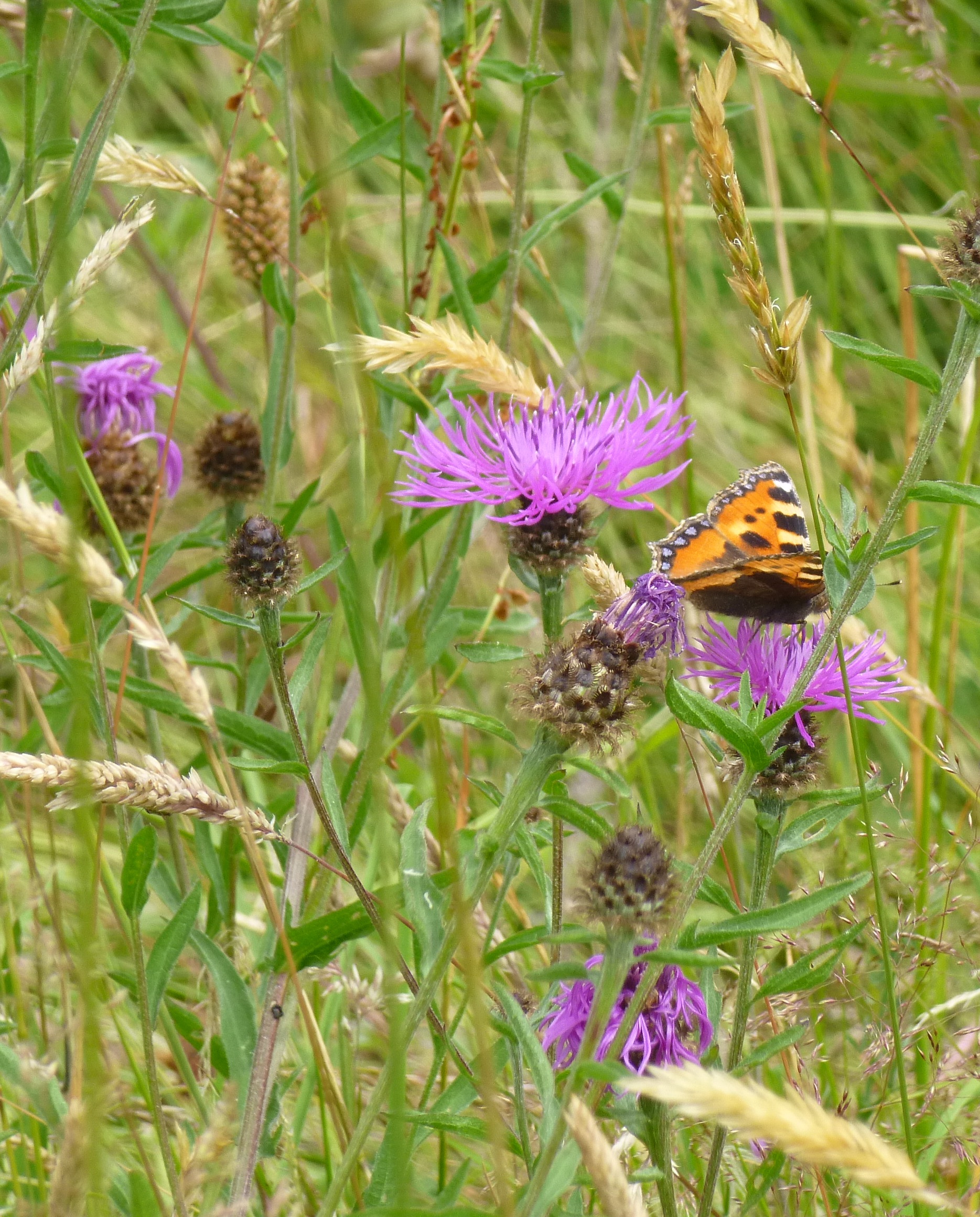 Knapweed (Centaurea nigra) (photo Sue Ashton)
Knapweed (Centaurea nigra) (photo Sue Ashton)
JULY 2021
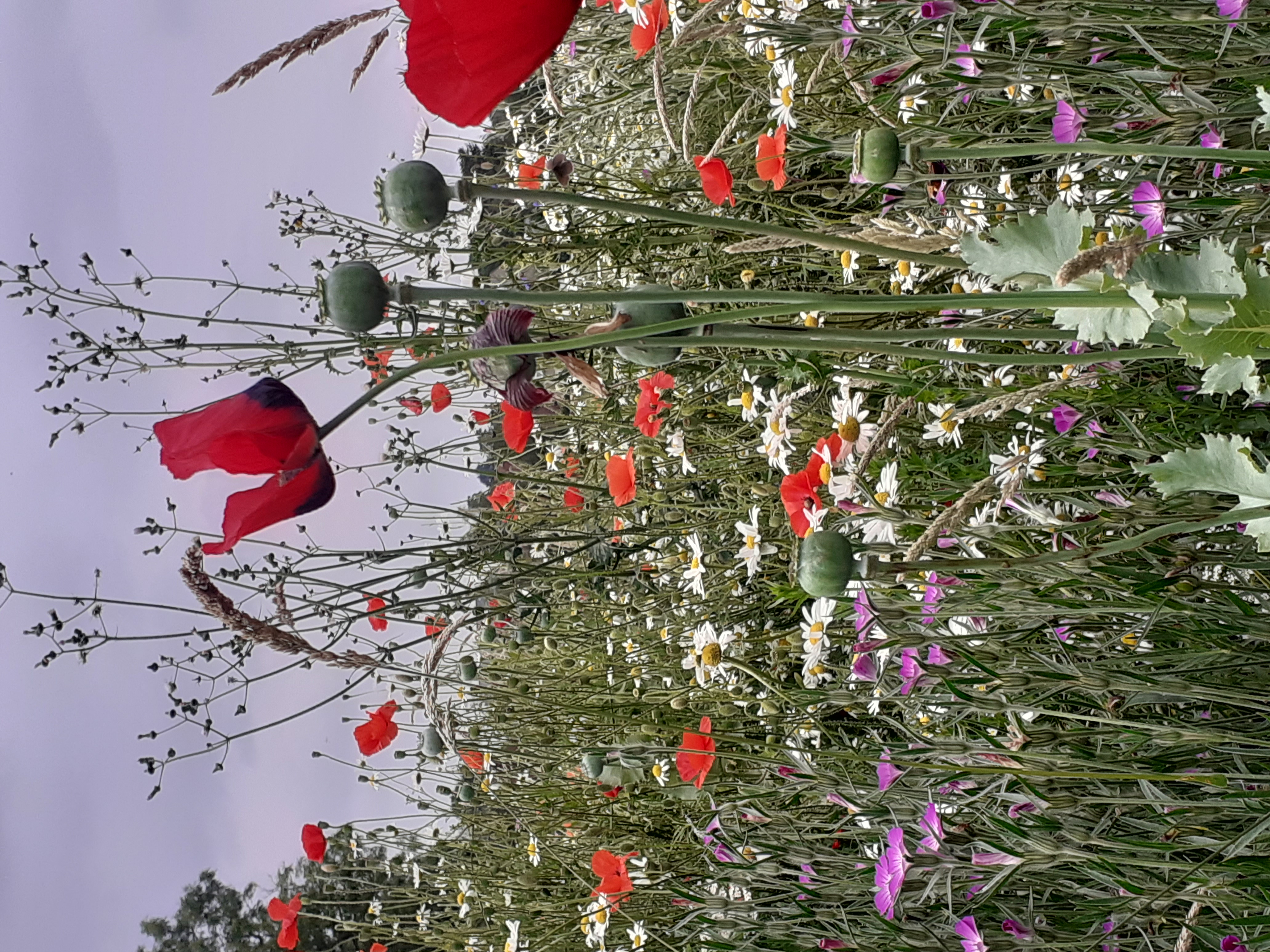 The new bee bank in flower
The new bee bank in flower
List of 46 flowering plants recorded at the woodland in July 2021:
Agrimony (Agrimonia eupatoria), Betony (Betonica officinalis), Bindweed (Calistegia sepium), Bramble (Rubus ulmifolius), Buddleia (Buddleia davidii), Common cat’s-ear (Hypochoeris radicata), Common mallow (Malva sylvestris), Cornflower (Centaurea cyanus), Corn Marigold (Glebionis segetum), Creeping buttercup (Ranunculus repens), Daisy (Bellis perennis), Dandelion (Taraxacum officinale), Dog daisy (Leucanthemum vulgare), Feverfew (Chrysanthemum parthenium), Field scabious (Knautia arvensis), Foxglove (Digitalis purpurea), Fringed water lily (Nymphoides peltata), Hedge bedstraw (Galium mollugo), Hedge parsley (Torilis japonica), Hogweed (Heracleum sphondylium), Honeysuckle (Lonicera periclymenum), Knapweed (Centaurea nigra), Lady’s bedstraw (Galium verum), Lesser bindweed (Convolvulus arvensis), Lesser yellow trefoil (Trifolium dubium), Long smooth-headed poppy (Papaver dubium), Marjoram (Origanum vulgare), Meadow buttercup (Ranunculus acris), Narrow-leaved bird’s-foot trefoil (Lotus uliginosus), Pickerel weed (Pontederia cordata), Purple loosestrife (Lythrum salicaria), Ragwort (Senecio jacobaea), Red campion (Silene doica), Rosa rugosa (Rosa rugosa), Soft hawksbeard (Crepis mollis), Sorrel (Rumex acetosa), Spear-leaved willow herb (Epilobium lanceolatum), Spear thistle (Cirsium vulgare), Spotted medick (Medicago arabica), Stinging Nettle (Urtica doica), Tansy (Tanacetum vulgare), Tufted vetch (Viccia cracca), White campion (Silene alba), White clover (Trifolium repens), White water lily (Nymphaea), Yarrow (Achillea millefolium).
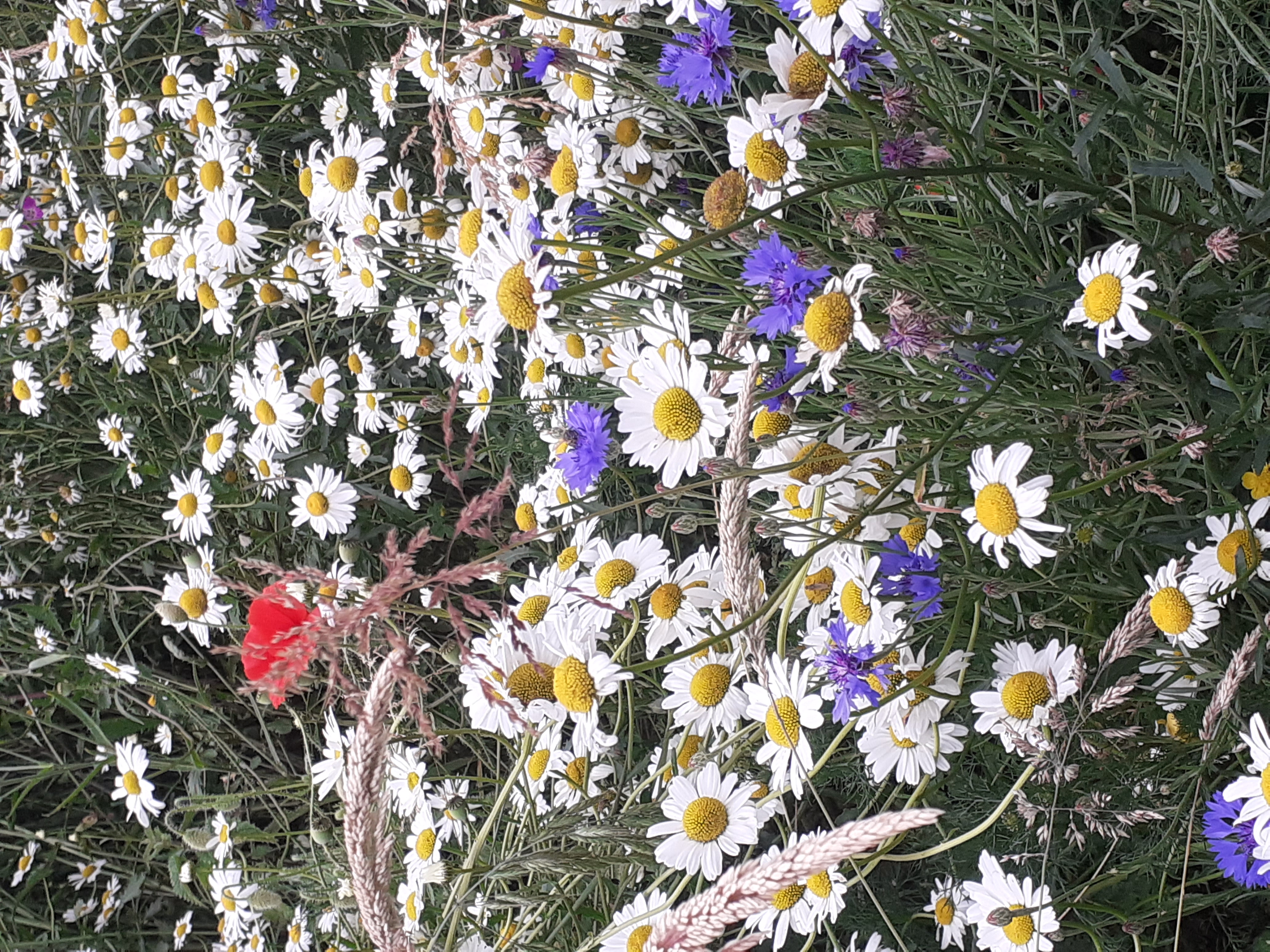 Cornflower and Dog daisy on the new bee bank
Cornflower and Dog daisy on the new bee bank
JUNE 2021
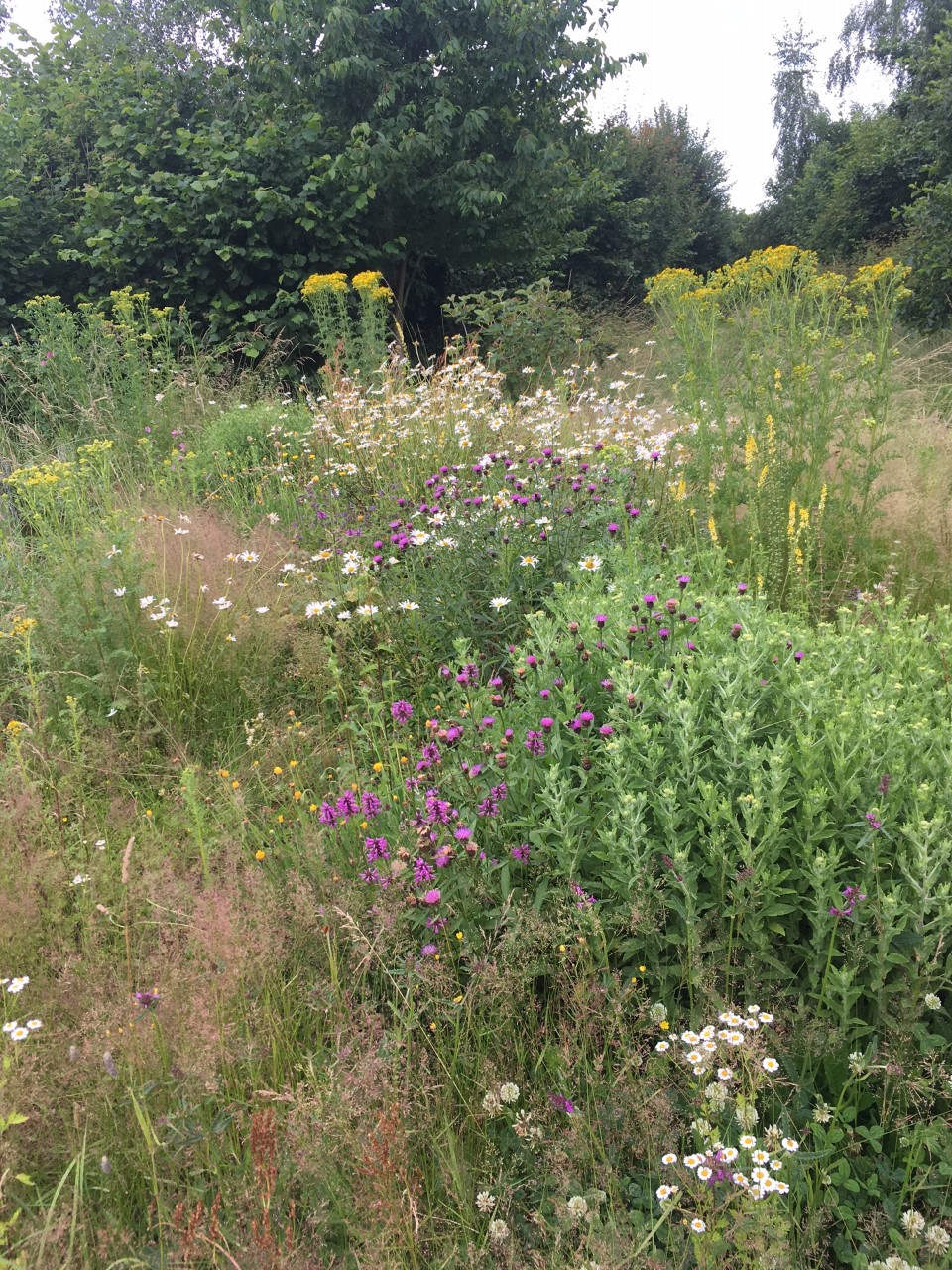 The bee bank by the pond in flower (photo Phil Stone)
The bee bank by the pond in flower (photo Phil Stone)
List of 57 flowering plants and grasses recorded at the Community Woodland in June 2021:
Agrimony (Agrimonia eupatoria), Bearded twitch (Agropyron canina), Betony (Betonica officinalis), Black medick (Medicago lupulina), Bramble (Rubus ulmifolius), Buddleia (Buddleia davidii), Cat’s ear (Hypochoeris radicata), Cock’s foot (Dactylis glomerata), Comfrey (Symphytum officinale), Common bent (Agrostis tenuis), Common mallow (Malva sylvestris), Cornflower (Centaurea cyanus), Creeping buttercup (Ranunculus repens), Creeping soft grass (Holcus mollis), Cut-leaved cranesbill (Geranium dissectum), Daisy (Bellis perennis), Dandelion (Taraxacum officinale), Dog daisy (Leucanthemum vulgare), Dog rose (Rosa canina), Feverfew (Chrysanthemum parthenium), Field scabious (Knautia arvensis), Fringed water lily (Nymphoides peltata), Hedge bedstraw (Galium mollugo), Herb Robert (Geranium robertianum), Hogweed (Heracleum sphondylium), Knapweed (Centaurea nigra), Lady’s bedstraw (Galium verum), Long smooth-headed poppy (Papaver dubium), Love-in-a-mist (Nigella), Marjoram (Origanum vulgare), Meadow buttercup (Ranunculus acris), Meadow cranesbill (Geranium pratense), Meadow foxtail (Alopecurus pratensis), Meadowsweet (Filipendula ulmaria), Narrow-leaved bird’s-foot trefoil (Lotus uliginosus), Pendulous sedge (Carex pendula), Pickerel weed (Pontederia cordata), Purple loosestrife (Lythrum salicaria), Red campion (Silene doica), Rosa rugosa (Rosa rugosa), Rough meadow grass (Poa trivialis), Rye grass (Lolium perenne), Self-heal (Prunella vulgaris), Smooth hawksbeard (Crepis capillaris), Sorrel (Rumex acetosa), Spear thistle (Cirsium vulgare), Stinging Nettle (Urtica doica), Teasel (Dipsacus fullonum),Timothy grass (Phleum pratense), Trailing rose (Rosa arvensis), Tufted vetch (Viccia cracca), White campion (Silene alba), White clover (Trifolium repens), White water lily (Nymphaea), Wild chamomile (Matricaria recutita), Woundwort (Stachys sylvatica), Yarrow (Achillea millefolium).
MAY 2021
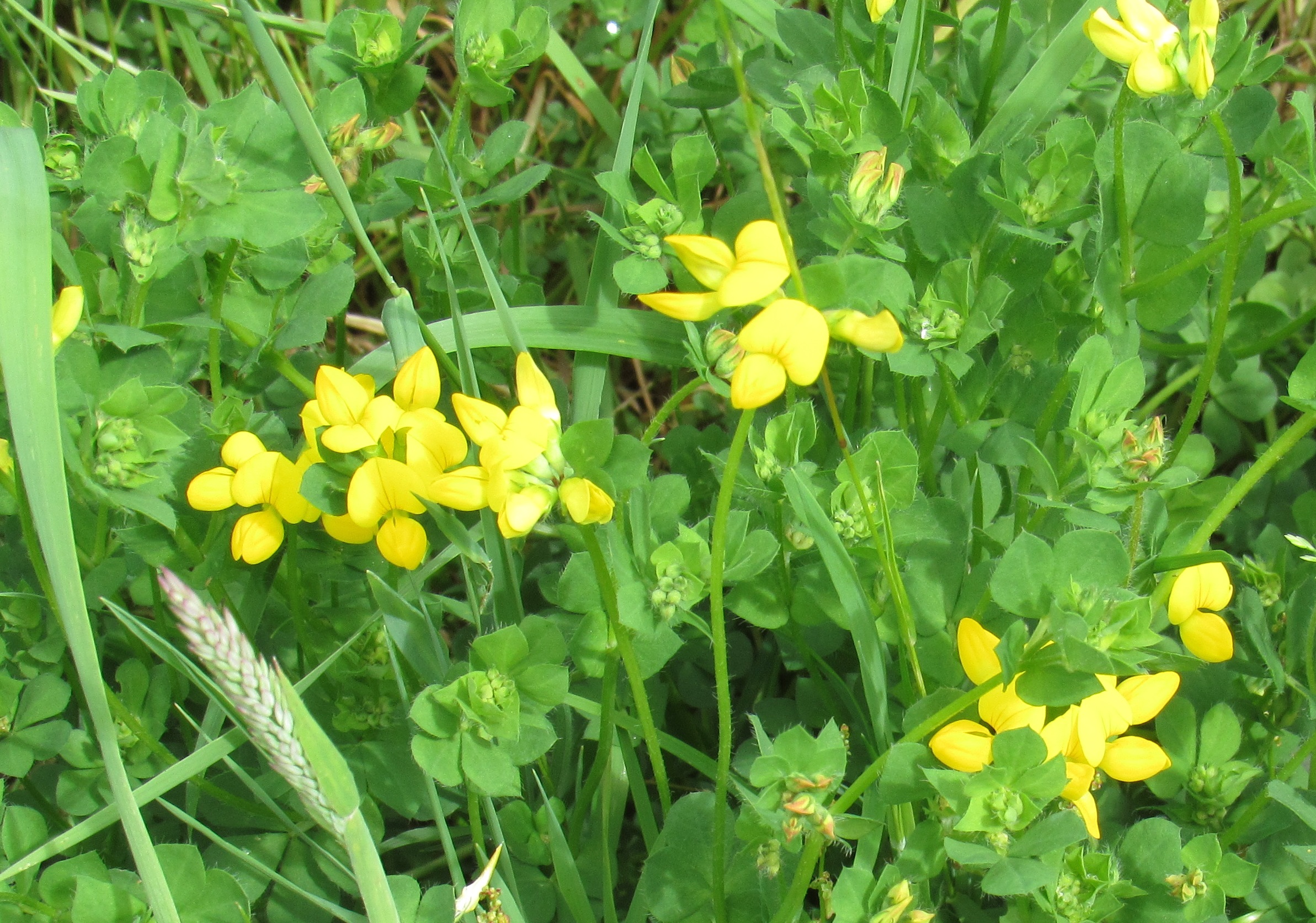 Bird's-foot trefoil at the woodland (photo Sue Ashton)
Bird's-foot trefoil at the woodland (photo Sue Ashton)
List of 33 flowering plants and grasses recorded at the woodland in May 2021:
Bird’s-foot trefoil (Lotus corniculatus), Buckthorn (Rhamnus cathartica), Cherry laurel (Prunus laurocerasus), Chickweed (Stellaria media), Cock’s foot (Dactylis glomerata), Cow parsley (Anthriscus sylvestris), Creeping buttercup (Ranunculus repens), Cut-leaved cranesbill (Geranium dissectum), Daisy (Bellis perennis), Dog daisy (Leucanthemum vulgare), Dogwood (Thelycrania sanguinea), Elder (Sambucus nigra), Garlic mustard (Alliaria petiolata), Ground ivy (Glechoma hederacea), Guelder rose (Viburnum opulus), Hawthorn (Crategus monogyna), Hedge bedstraw (Galium album), Hogweed (Heracleum sphondylium), Knapweed (Centaurea nigra), Meadow buttercup (Ranunculus acris), Meadow fescue (Festuca pratensis), Meadow foxtail (Alopecurus pratensis), Mrs Robb’s bonnet (Euphorbia amygdaloides robbiae), Red campion (Silene doica), Rowan (Sorbus acuparia), Scarlet pimpernel (Anagallis arvensis), Sorrel (Rumex fruticosis), Stinging nettle (Urtica doica), Trailing rose (Rosa arvensis), Wayfaring tree (Viburnum lantana), White clover (Trifolium repens), Yarrow (Achillea millefolium), Yellow flag (Iris pseudacorus).
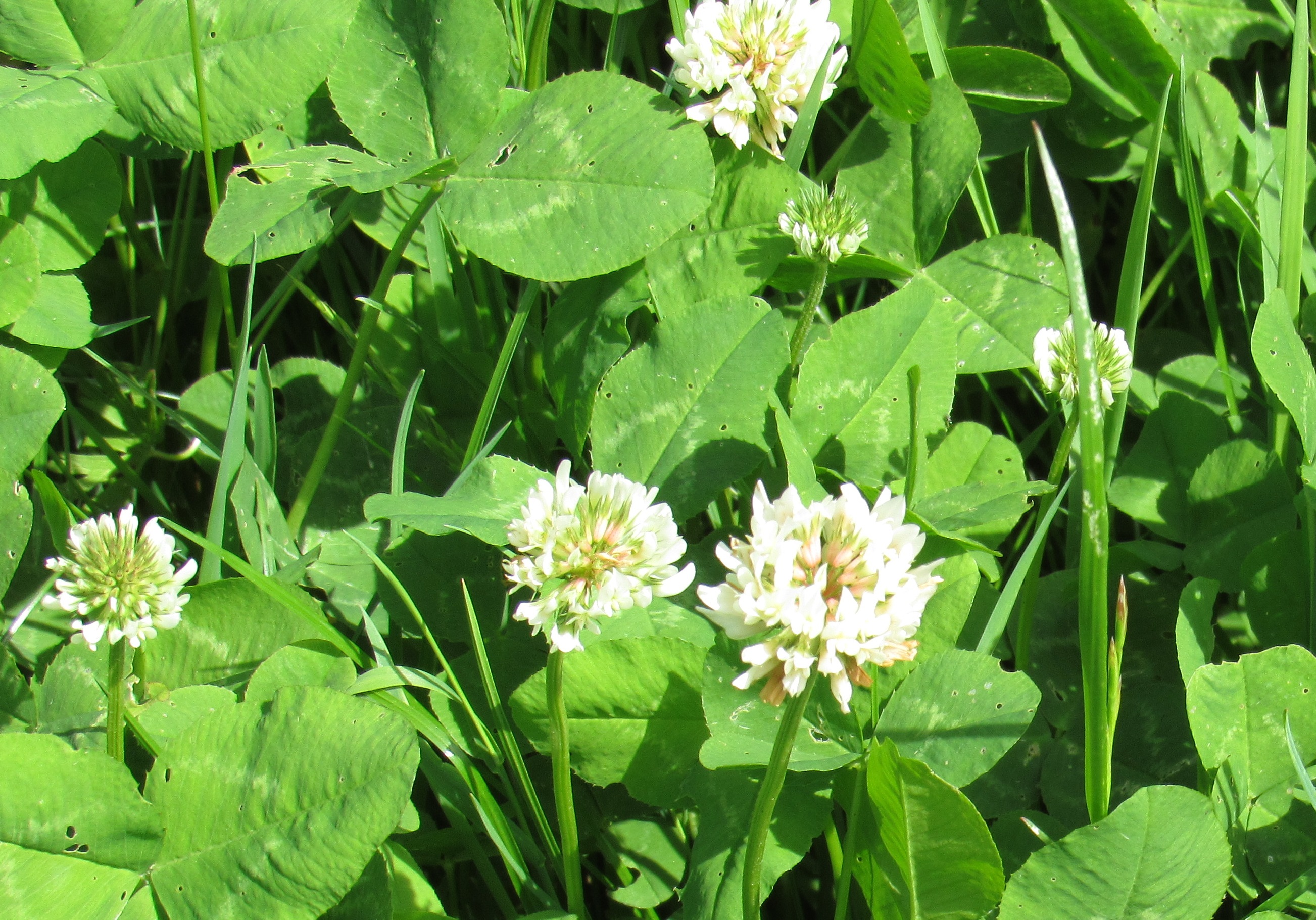 White clover (photo Sue Ashton)
White clover (photo Sue Ashton)
APRIL 2021
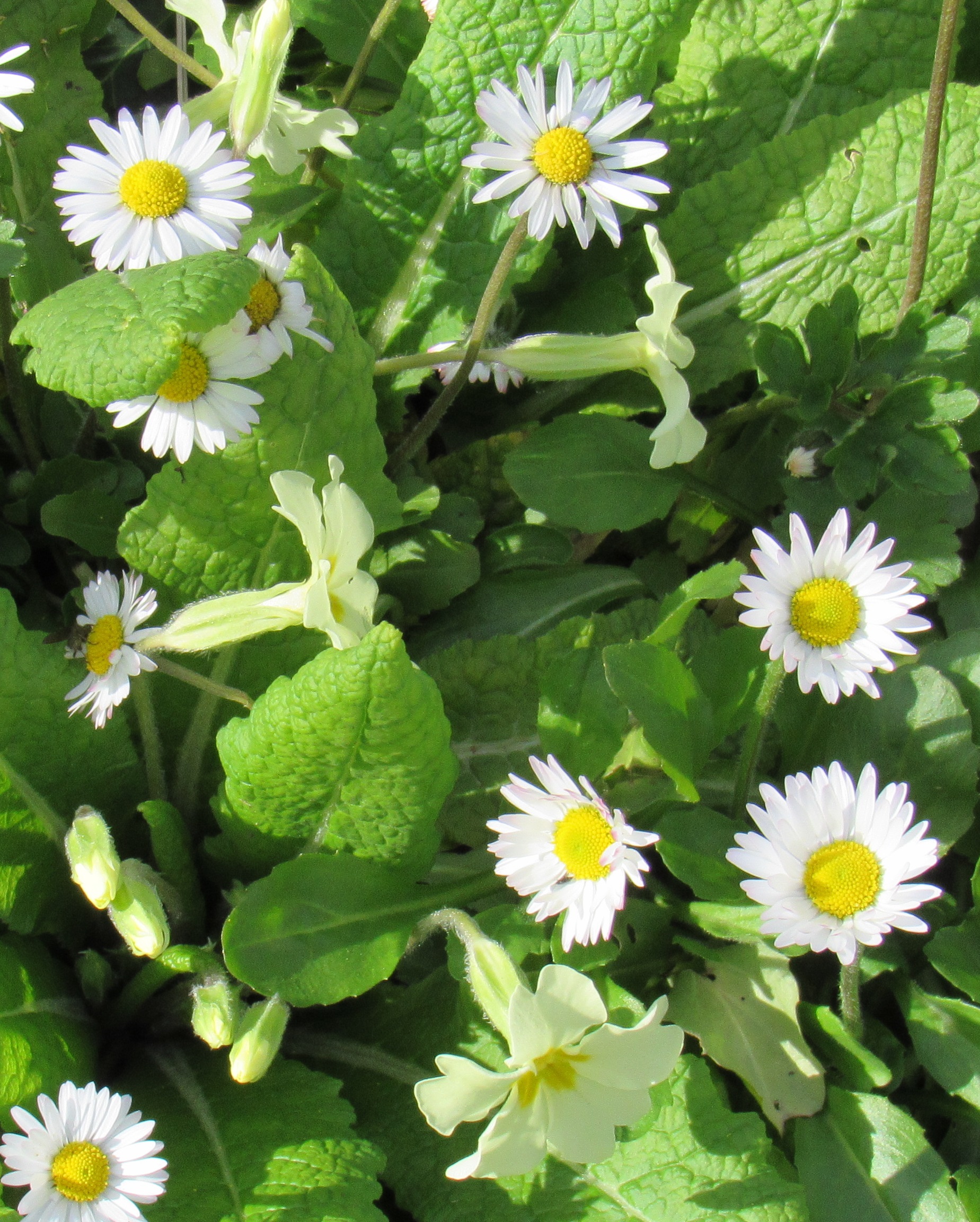 Daisy and Primrose (photo Sue Ashton)
Daisy and Primrose (photo Sue Ashton)
List of 27 flowering plants recorded at the Community Woodland in April 2021:
Arum lily (Arum maculatum), Blackthorn (Prunus spinosa), Bluebell (Endymion non-scriptus), Celandine (Ficaria verna), Cherry laurel (Prunus laurocerasus), Chickweed (Stellaria media), Comfrey (Symphytum officinale), Common speedwell (Veronica officinalis), Cow parsley (Anthriscus sylvestris), Cowslip (Primula veris), Creeping buttercup (Ranunculus repens), Daisy (Bellis perennis), Dandelion (Taraxacum officinale), Forget-me-not (Myosotis sylvatica), Greater periwnkle (Vinca major), Ground ivy (Glechoma hederacea), Groundsel (Senecio vulgaris), Mrs Robb’s bonnet (Euphorbia amygdaloides robbiae), Plum (Prunus domestica), Primrose (Primula vulgaris), Purple deadnettle (Lamium purpureum), Red campion (Silene doica), Sherpherd’s purse (Capsella bursa-pastoris), Viburnum (Viburnum tinus), Wayfaring tree (Viburnum lantana), Wild cherry (Prunus avium), Wild garlic (Allium ursinum).
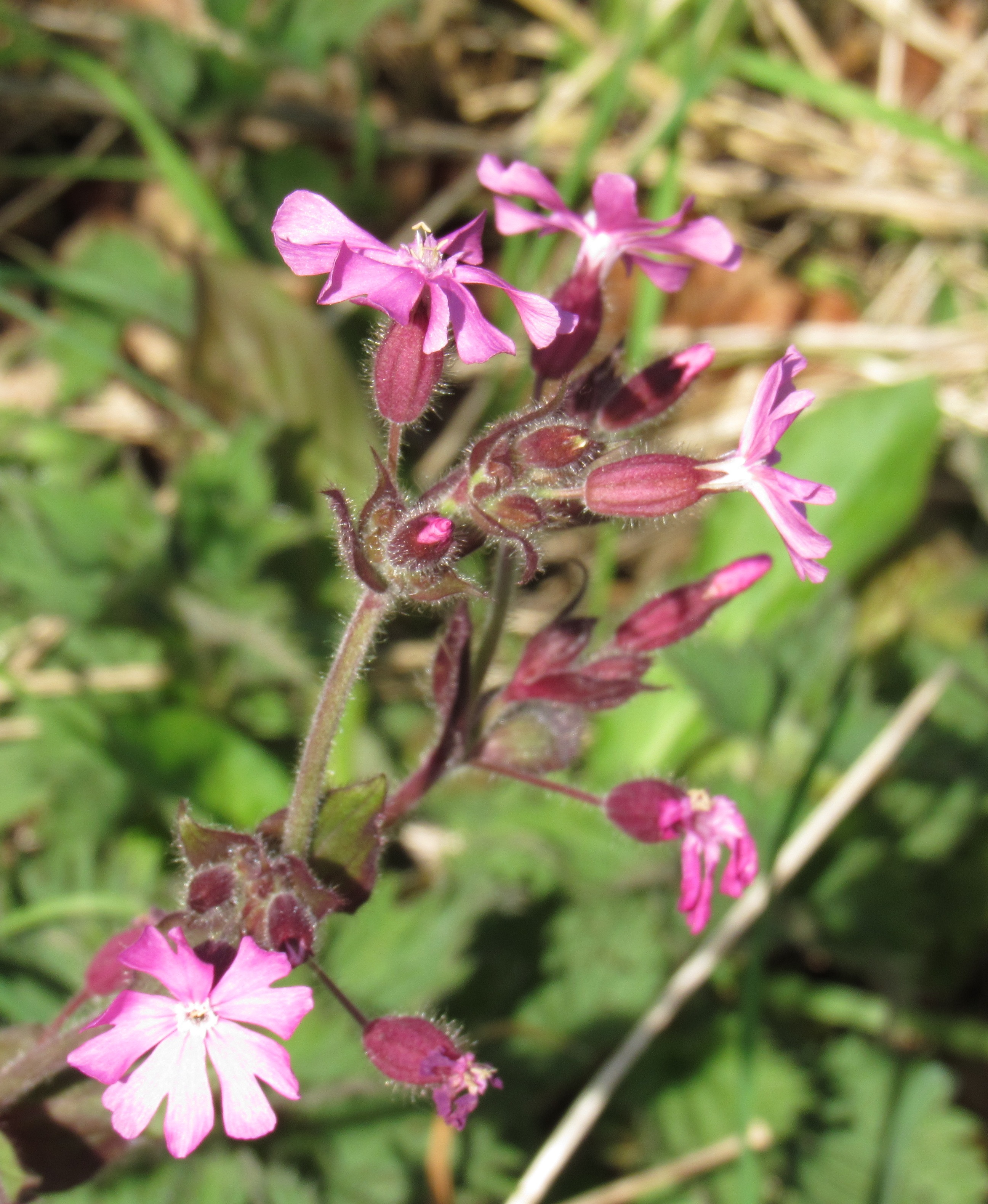 Red campion (photo Sue Ashton)
Red campion (photo Sue Ashton)
JULY 2020
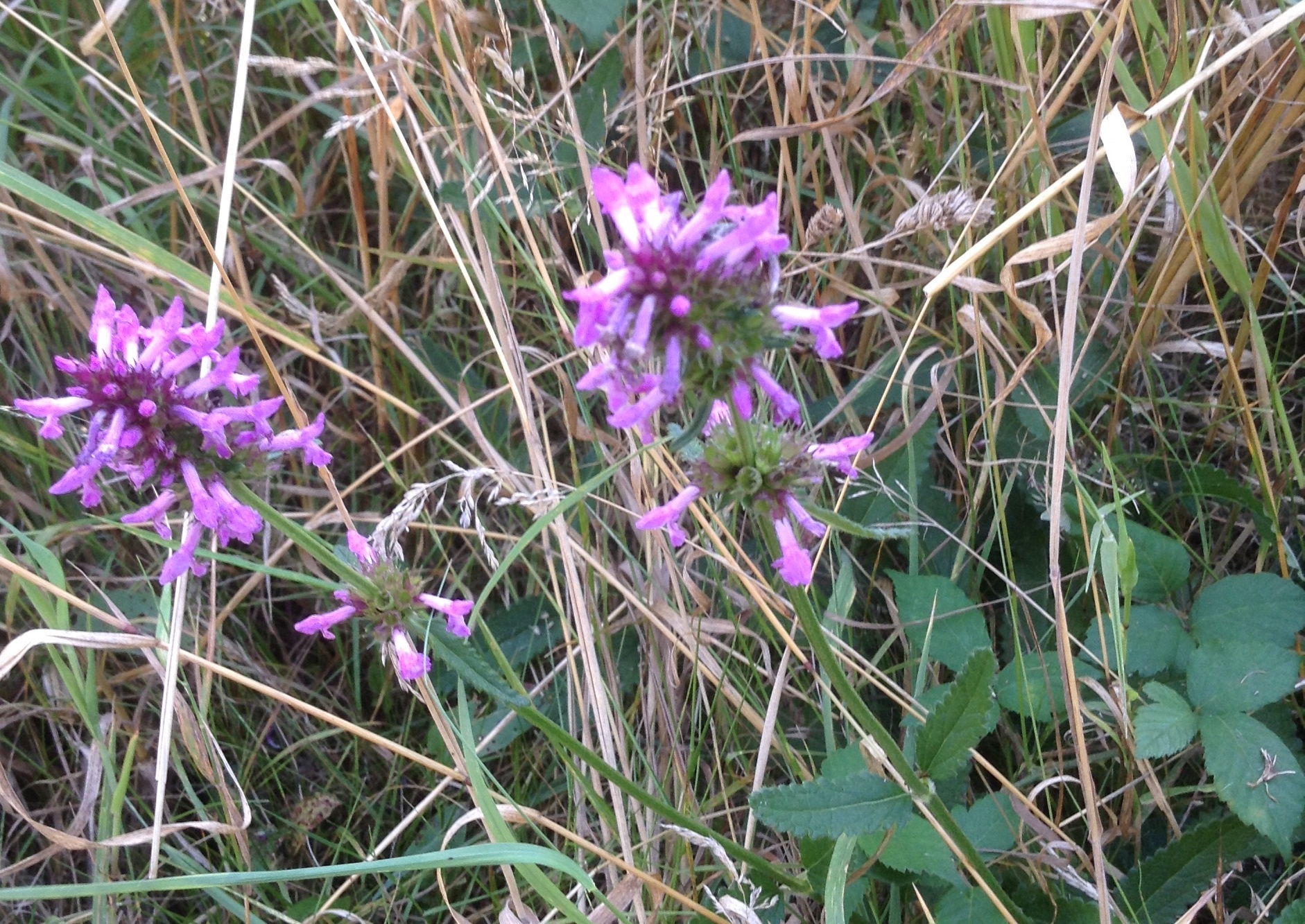 Betony
Betony
List of 40 flowering plants recorded at the Community Woodland in July 2020:
Betony (Betonica officinalis), Bindweed (Calystegium sepium), Bird’s-foot trefoil (Lotus corniculatus), Bramble (Rubus ulmifolius), Buddleia (Buddleia davidii), Common hawkbit (Leontodon taraxacoides), Common mallow (Malva sylvestris), Common red poppy (Papaver rhoeas), Common teasel (Dipsacus fullonum), Cornflower (Centaurea cyanus), Corn Chamomile (Anthemis arvensis), Corn marigold (Chrysanthemum segetum), Cow parsley (Anthriscus sylvestris), Creeping buttercup (Ranunculus repens), Daisy (Bellis perennis), Dog daisy (Leucanthemum vulgare), Field scabious (Knautia arvensis), Hedge parsley (Torilis japonica), Herb Robert (Geranium robertianum), Hogweed (Heracleum sphondylium), Honeysuckle (Lonicera periclymenum), Knapweed (Centaurea nigra), Lady’s bedstraw (Galium verum), Least yellow trefoil (Trifolium micranthum), Lesser spearwort (Ranunculus flammula), Marjoram (Origanum vulgare), Meadow buttercup (Ranunculus acris), Meadow cranesbill (Geranium pratense), Meadowsweet (Filipendula ulmaria), Nipplewort (Lapsana communis), Pickerel weed (Pontederia cordata), Prickly lettuce (Lactua serriola), Purple loosestrife (Lythrum salicaria), Ragwort (Senecio jacobaea), Rosa rugosa (Rosa rugosa), Spear-leaved Willow Herb (Epilobium lanceolatum), Spear thistle (Cirsium vulgare), White clover (Trifolium repens), Wild Carrot (Daucus carota), Yarrow (Achillea millefolium).
Yarrow
JUNE 2020
Cornflower
List of 52 flowering plants recorded at the Community Woodland in June 2020:
Betony (Betonica officinalis), Bindweed (Calystegium sepium), Bird’s foot trefoil (Lotus corniculatus), Bramble (Rubus ulmifolius), Buddleia (Buddleia davidii), Common mallow (Malva sylvestris), Common red poppy (Papaver rhoeas), Corncockle (Agrostemma githago), Cornflower (Centaurea cyanus), Corn marigold (Chrysanthemum segetum), Cow parsley (Anthriscus sylvestris), Creeping buttercup (Ranunculus repens), Cut-leaved cranesbill (Geranium dissectum), Daisy (Bellis perennis), Dog daisy (Leucanthemum vulgare), Field scabious (Knautia arvensis), Garlic mustard (Alliaria petiolata), Greater celandine (Chelidonium majus), Hedge bedstraw (Galium mollugo), Herb Robert (Geranium robertianum), Hogweed (Heracleum sphondylium), Honeysuckle (Lonicera periclymenum), Knapweed (Centaurea nigra), Lady’s bedstraw (Galium verum), Least yellow trefoil (Trifolium micranthum), Lesser bindweed (Calystegium arvensis), Lesser spearwort (Ranunculus flammula), Marjoram (Origanum vulgare), Meadow buttercup (Ranunculus acris), Meadow foxtail (Alopecurus pratensis), Meadowsweet (Filipendula ulmaria), Mint (Mentha spicata), Narrow-leaved bird’s-foot trefoil (Lotus uliginosus), Nettle (Urtica doica), Nigella (Nigella), Nipplewort (Lapsana communis), Pickerel weed (Pontederia cordata), Purple loosestrife (Lythrum salicaria), Ragwort (Senecio jacobaea), Red campion (Silene doica), Rosa rugosa (Rosa rugosa), Self-heal (Prunella vulgaris), Smooth hawksbeard (Crepis capillaris), Sorrel (Rumex acetosa), Spear thistle (Cirsium vulgare), Timothy grass (Phleum pratense), Trailing rose (Rosa arvensis), Vervain (Verbena officinalis), White campion (Silene alba), White clover (Trifolium repens), Wood avens (Geum urbanum), Yarrow (Achillea millefolium).
Field scabious
A Posy of Geraniums
The flowers are the most noticeable aspect of this group of plants at this time of year and all are to be found in the Community Woodland. It is worth looking later in the summer to see the dainty seed capsules that look like bird’s beaks; hence the common name of Stork’s-bill for Geranium pratense. These ‘beaks’ split open and fling the seeds widely, a very effective seed-dispersal mechanism!
Meadow Cranesbill (Geranium pratense) 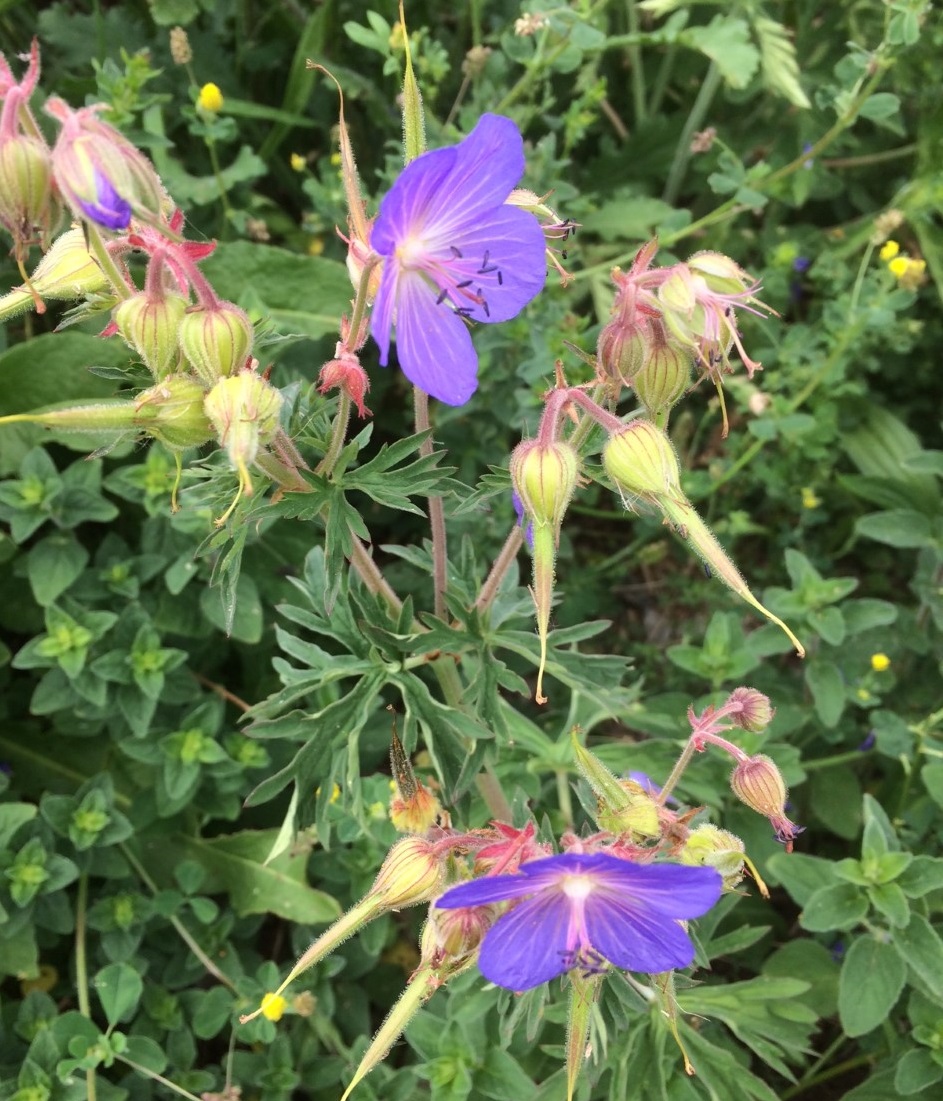
Although generally very common, this beautiful blue flower has just started to appear in the Community Woodland.
The large blue flowers have five petals with faint veins on them. They can grow to a large clump of up to a metre tall and will tolerate a good deal of shade.
They have been used in cultivation to provide many different attractive varieties and are rightly popular with gardeners, and with bees!
Herb Robert (Geranium robertianum) 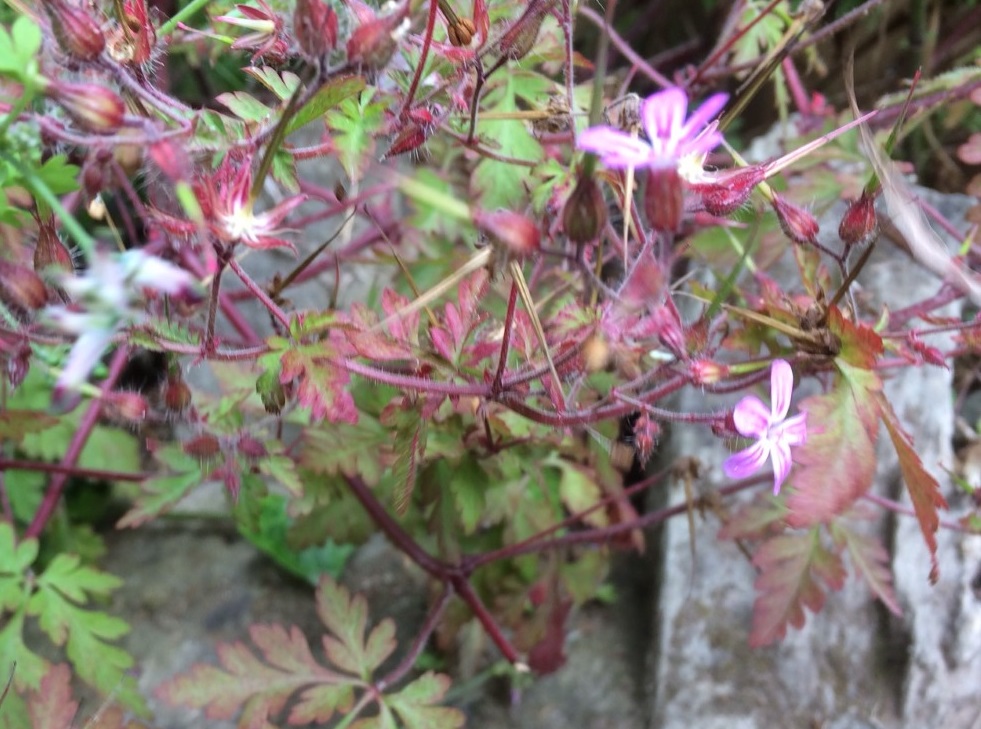
The Robert that this pretty plant has been named after was a French abbot and herbalist in the eleventh century. He used it for cures ranging from diarrhoea to toothache! If you rub yourself with the leaves it is said to repel mosquitoes.
It has a bright pink flower and the stems are red; also the leaves by the end of its flowering period. It is very common on waste ground and it seeds readily.
Cut-leaved Geranium (Geranium dissectum)
The flowers of this geranium are tiny and purple pink. The most distinctive thing about it are the beautifully shaped leaves, with divisions so deep they almost reach the base of the leaf. The plant is rich in tannin and, if you could ever collect enough, a brown dye can be made from the flowers.
In the Pond Area
Pickerel Weed (Pontederia cordata)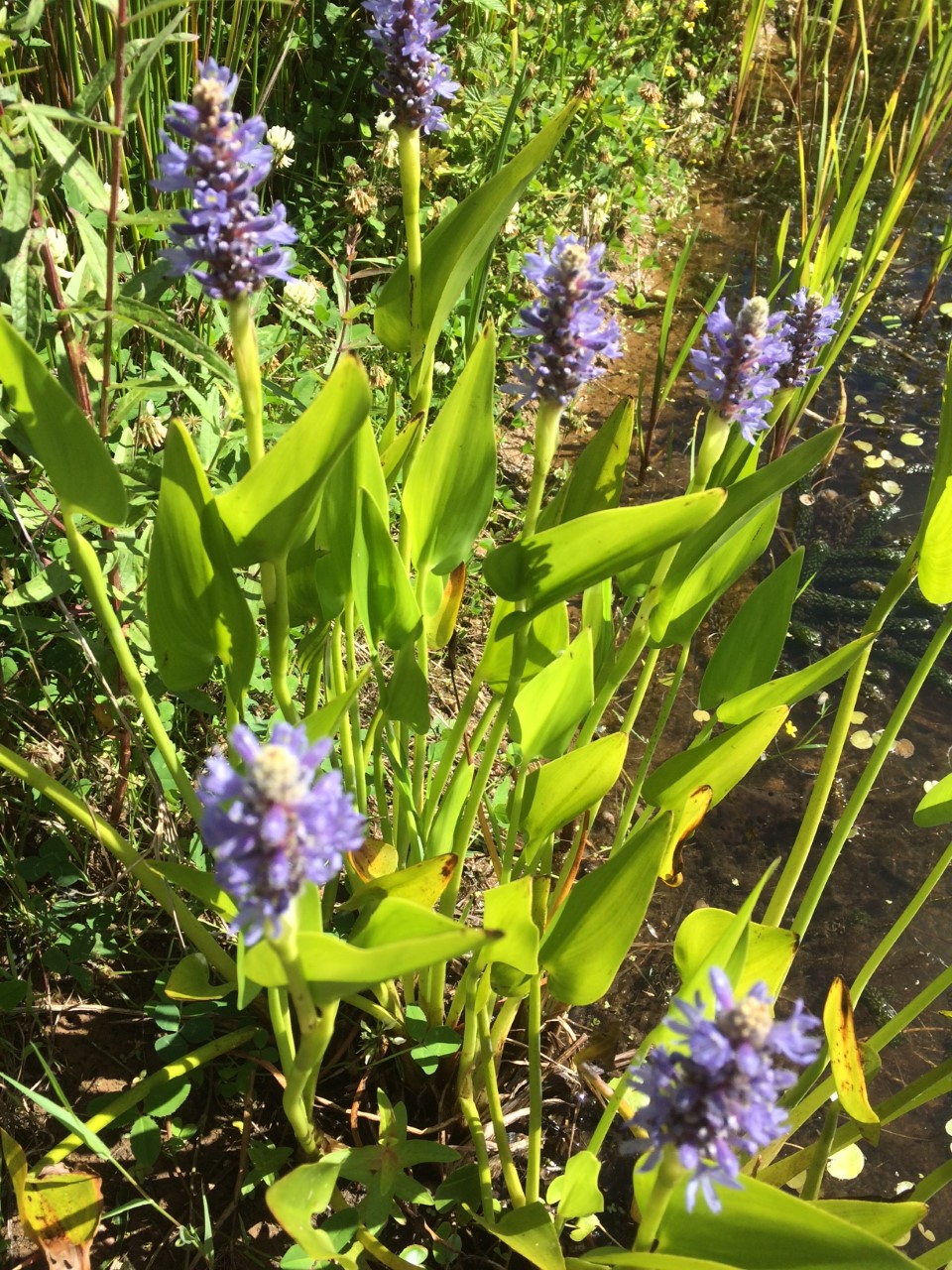
This is a marginal water plant which can cope with fluctuating water levels. The leaves are lance shaped and the flowers a showy purple which are attractive to bees.
After seeds form, the stem sinks below water level and the seeds disperse in the pond. It can also spread very efficiently by branching rhizomes.
You can roast the seeds and eat them like nuts or cook the leafstalks, but probably best to leave them to deer who apparently are very fond of them!
Meadowsweet (Filipendula ulmaria)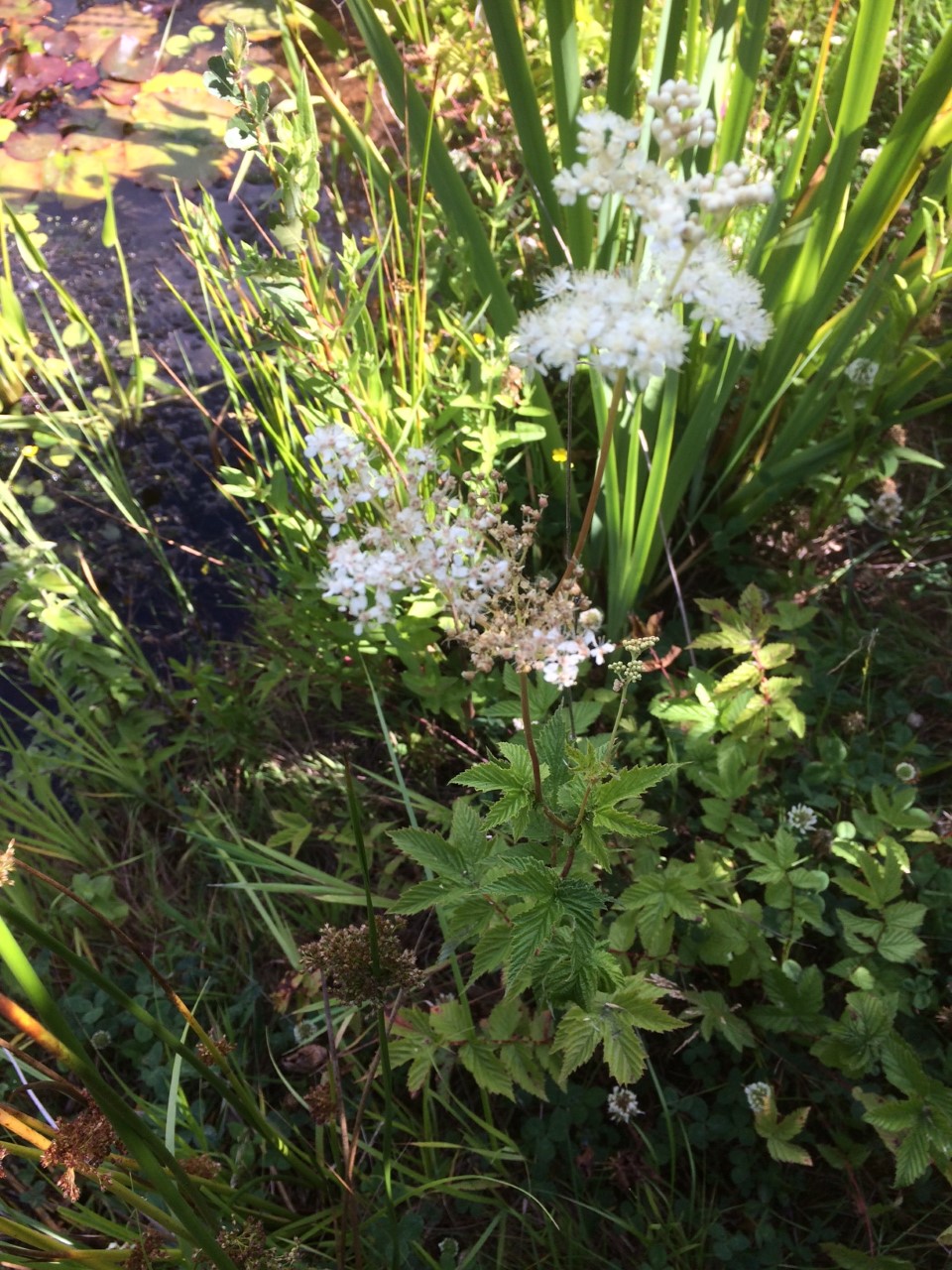
These common but showy plants grow happily along local rhynes such as on Moor Lane.
If you look very closely, the tiny flowers are from the Rosaceae family and smell sweet. Maybe this is why they were used to strew in churches for weddings and festivals. Queen Elizabeth I was particularly fond of them on her bedroom floor!
Lesser Spearwort (Ranunculus flammula)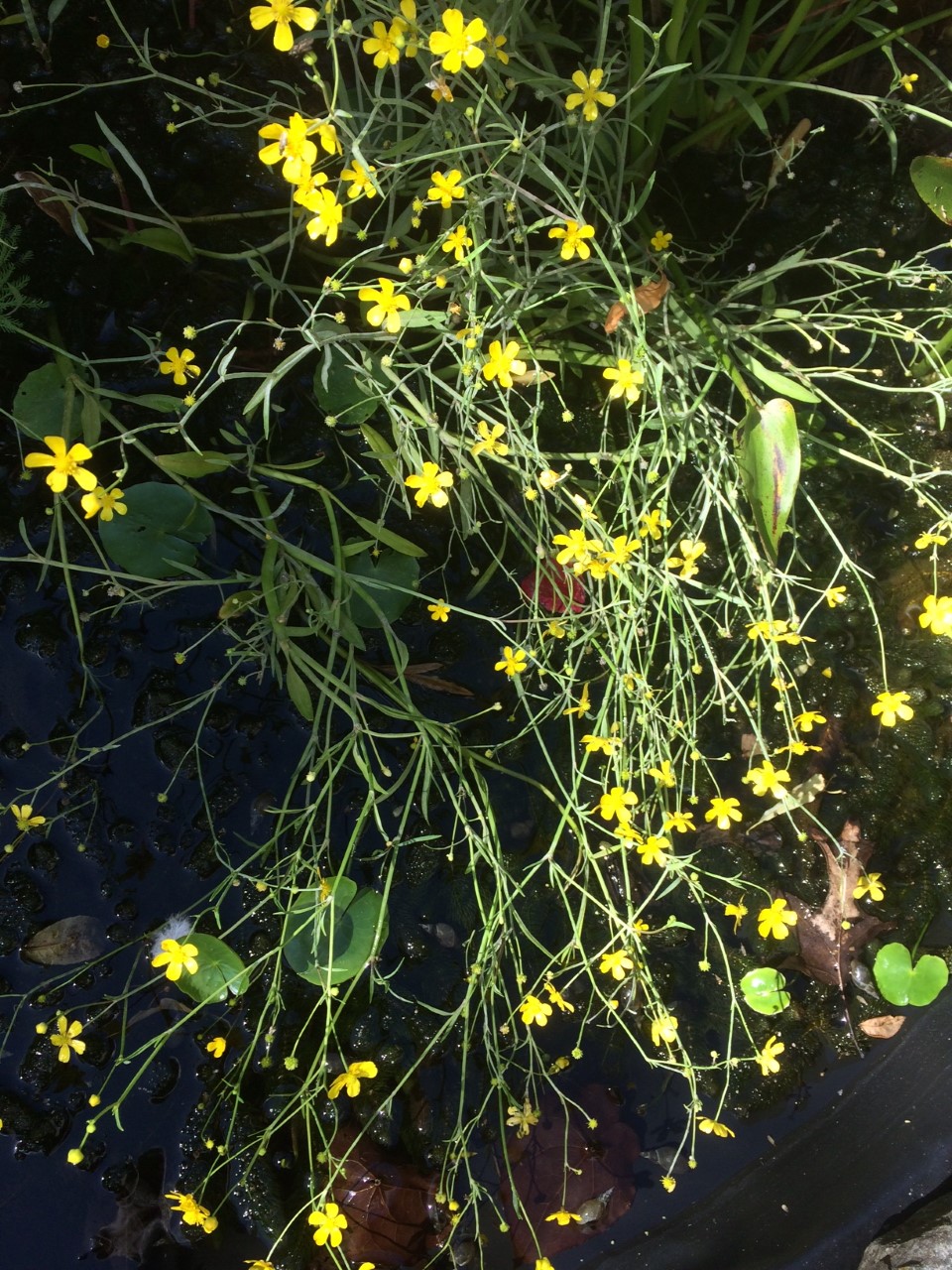
This is very like the Creeping buttercup in the same family which is so common in fields and hedgerows, but this one likes damp or wet places and will even thrive in open water.
It is widespread with pretty yellow flowers and is poisonous!
Purple Lossestrife (Lythrum salicaria)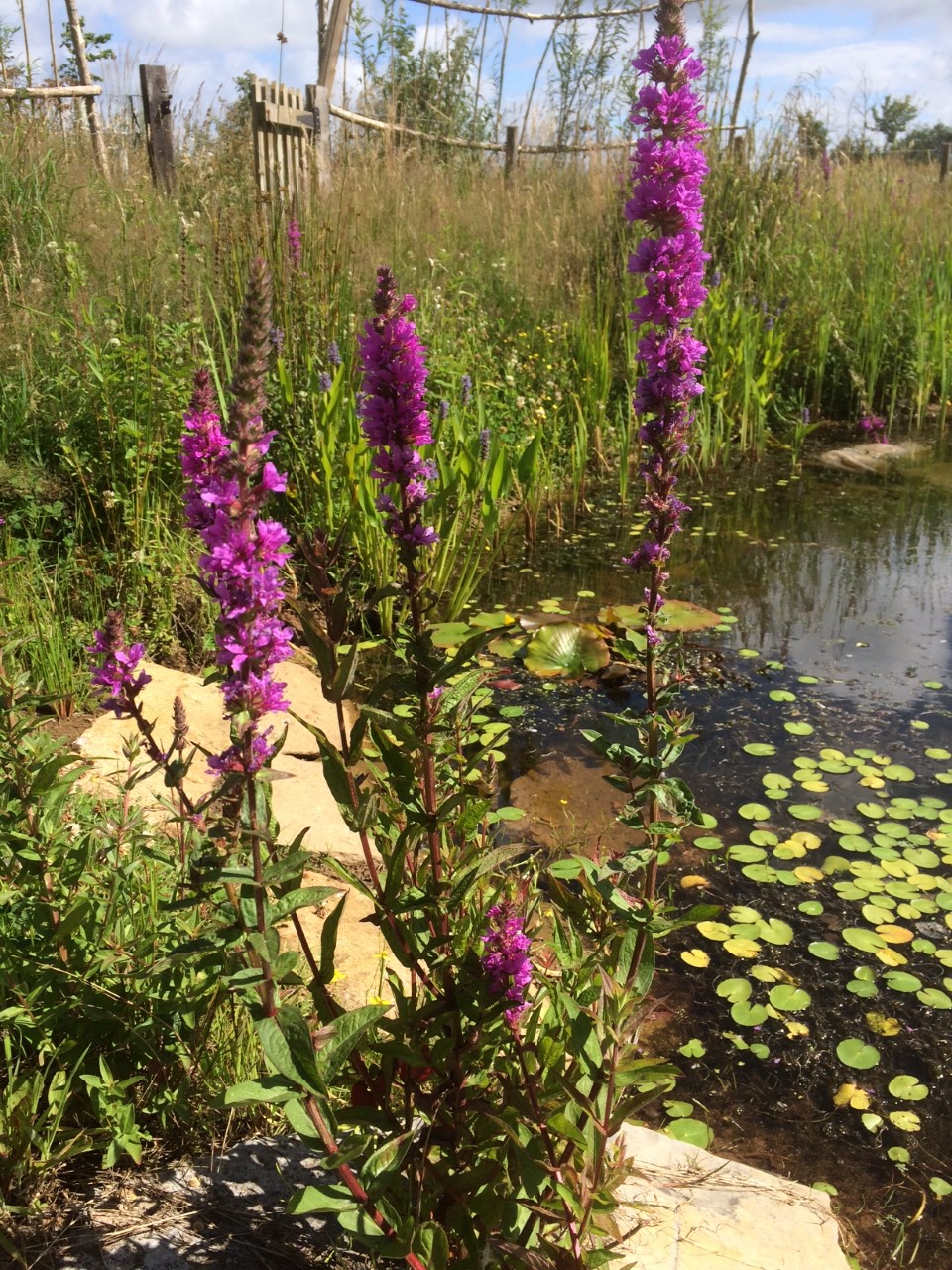
This plant is from the Lithraceae family, not the Primulaceae like the other loosestrifes. It has beautiful bright magenta-purple flowers and looks stunning in numbers along watersides and in bogs and marshes.
It is a food plant for many beetles, weevils and caterpillars but seems to do very well despite this!
It has become a pest in the USA and New Zealand as it crowds out other species. However, it is so attractive that it’s possible to buy some forms with an AGM (Award of Garden Merit) from the RHS!
Musk Mallow (Malva moschata) 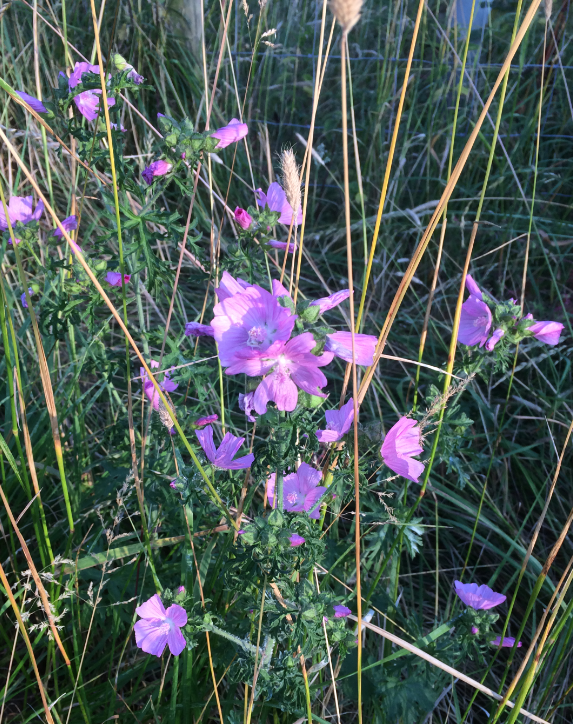
Musk Mallow is an ornamental plant which thrives on dry soil but it seems very happy by the pond!
Cultivated forms are available for gardens too. The seeds, leaves and flowers are all edible in salads. It has been discovered that the root can help control blood sugar levels.
Spear Thistle (Cirsium vulgare)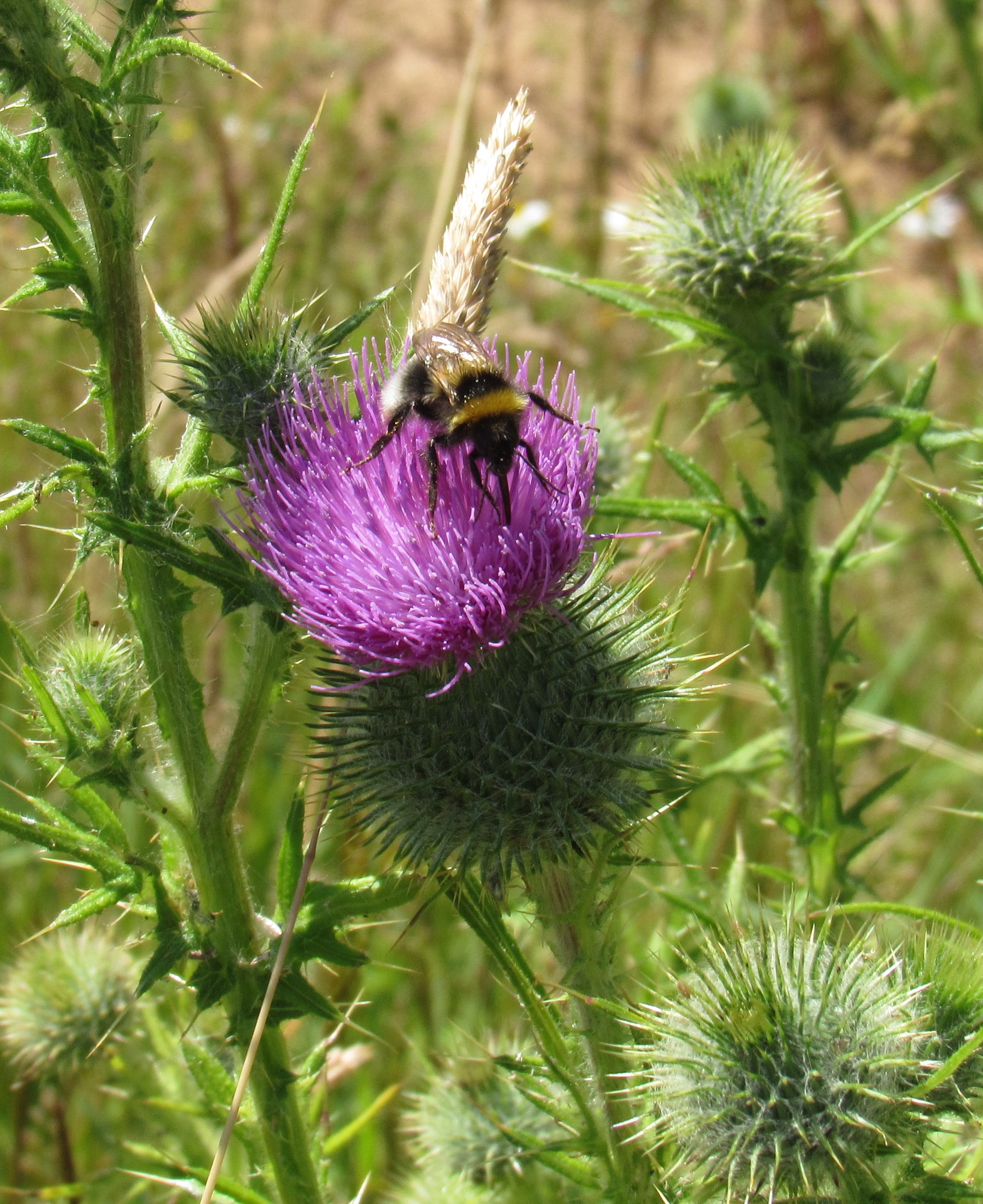
This thistle is a big, energetic plant with beautiful purple flowers. It can grow to 1.5 metres and the deep tap root makes it a difficult plant to remove if you find it in the garden. However, it is in the top ten of the best nectar producers so well worth growing!
APRIL 2020
List of 16 flowering plants recorded at the Community Woodland in April 2020:
Clustered mouse-ear (Cerastium glomeratum), Cowslip (Primula veris), Creeping buttercup (Ranunculus repens), Dandelion (Taraxacum officinale), Garlic mustard (Alliaria petiolata), Hairy bittercress (Cardamine hirsuta), Herb Robert (Geranium robertianum), Lesser celandine (Ficaria verna), Lords and ladies (Arum maculatum), Plum sp. (Prunus domestica), Primrose (Primula vulgaris), Purple deadnettle (Lamium purpureum), Rape (Brassica napus), Spanish bluebell (Endymion hispanicus), Speedwell (Veronica persica), Wood anemone (Anemone nemorosa).
Rays of Spring Sunshine!
Dandelion (Taraxacum officinale) 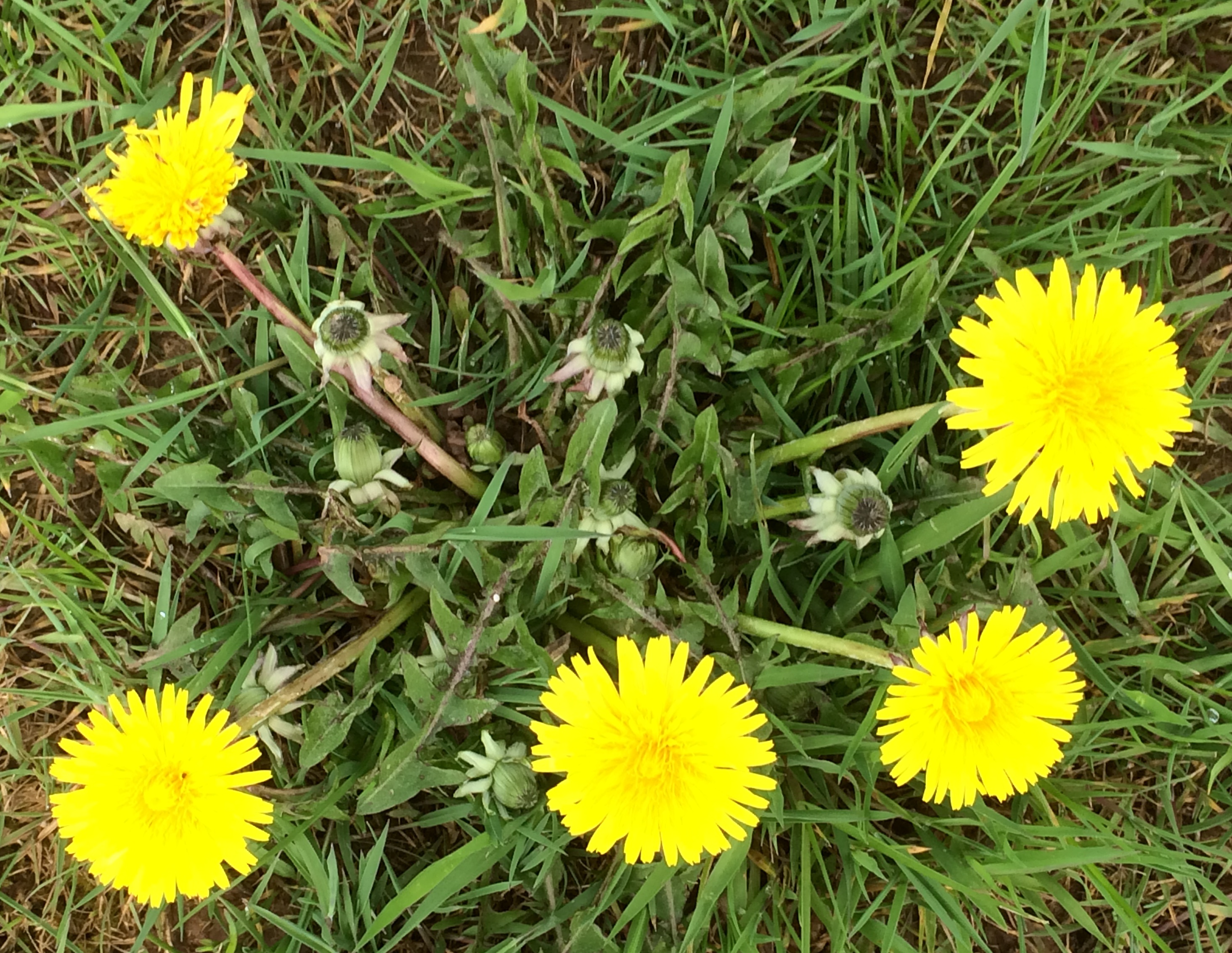
Often abused for their tendency to spoil lawns, they are one of the earliest pollen flowers in spring. Any gardener will tell you that unless you remove their long tap root they will regrow.
They get their name from the French dent de lion as the leaves were thought to resemble a lion’s tooth. All their parts are edible – the leaves are like spinach! The seeds spread by means of their tiny parachutes to any rough soil.
Lesser Celandine (Ficaria verna) 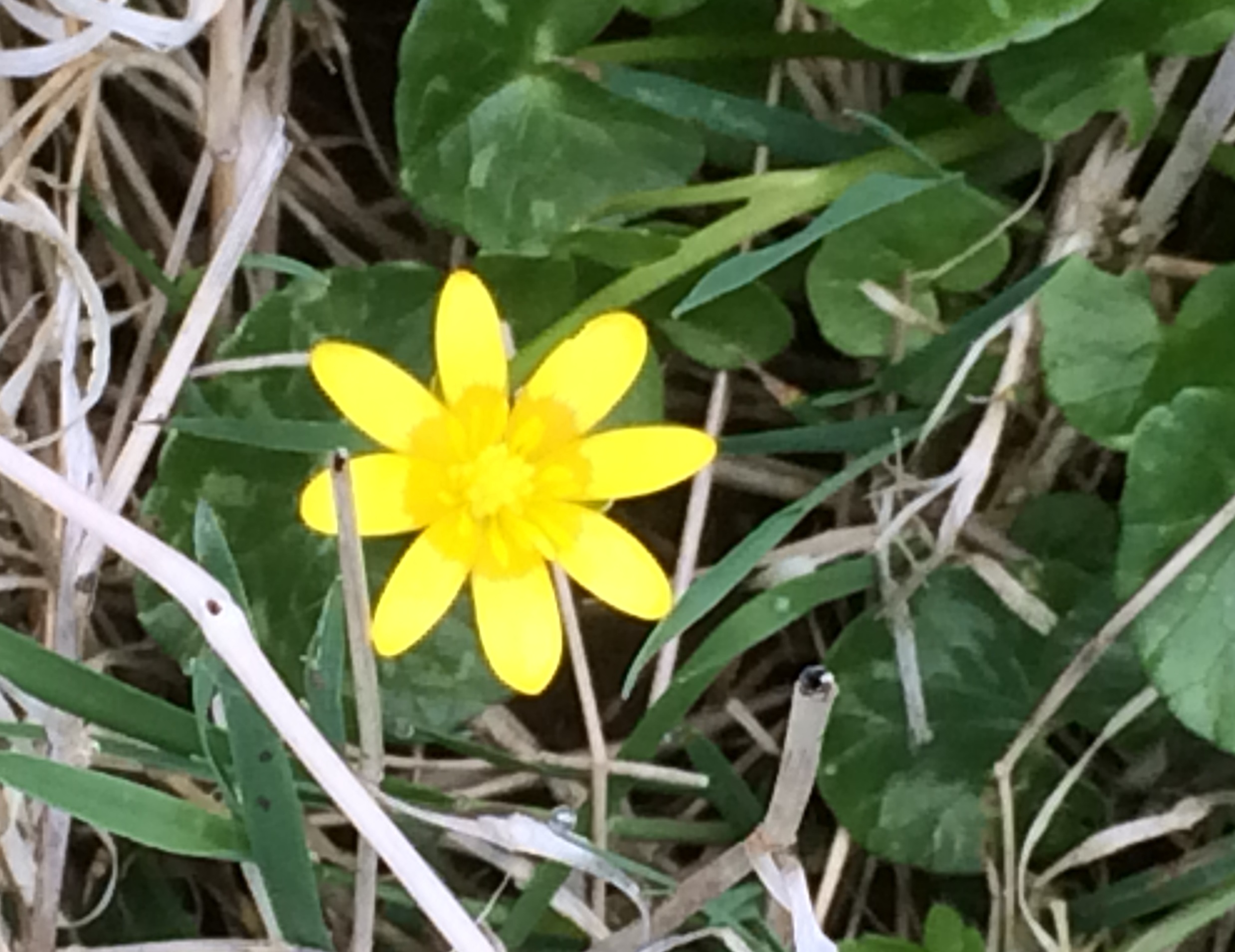
Although only mildly toxic to humans, the Celandine is sufficiently toxic to grazing livestock that in the US it is listed as a ‘noxious weed’ and must be got rid of!
Below the plant are tiny round tubers which will break off and start a new plant so they are difficult to eradicate.
However, the shiny bright glow of the flowers is a pleasure!
Greater Celandine (Chelidonium majus)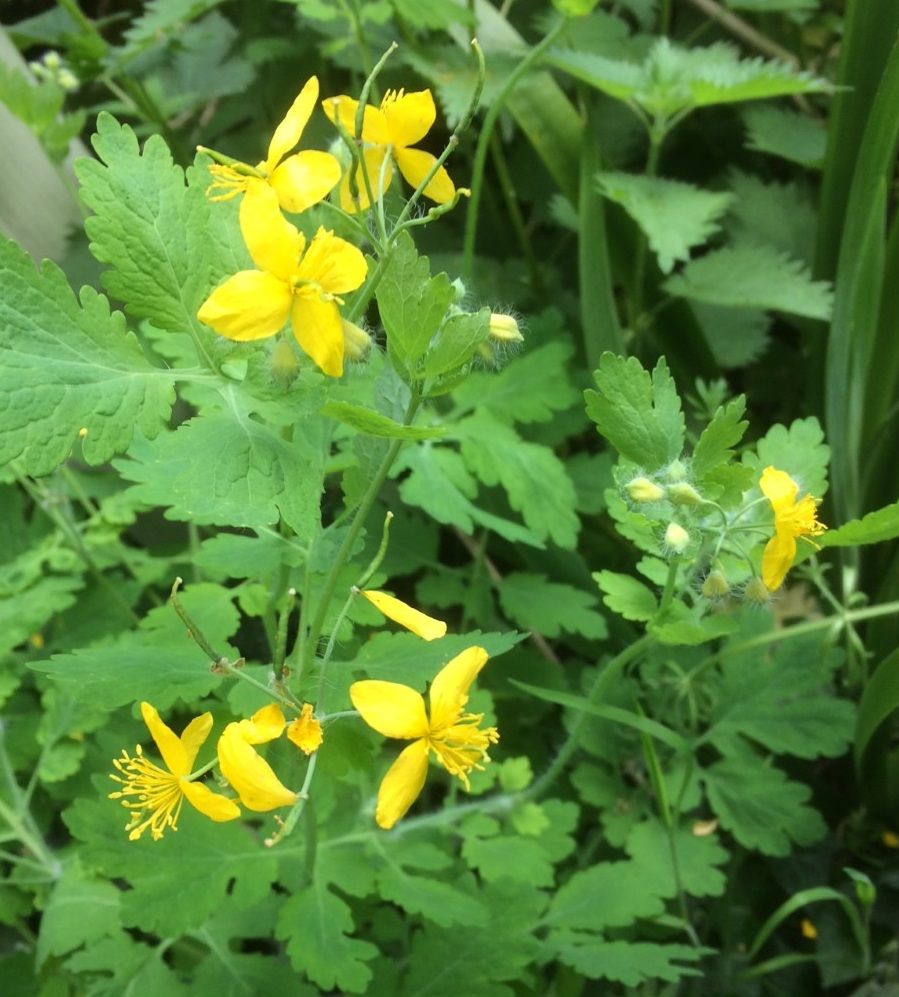
This tall plant of woodland paths and hedgerows has appeared this year (2020) beside the path through the Copse.
It bears little relationship to the Lesser Celandine apart from its bright yellow flowers, and it is in a different flower family altogether. It belongs with the poppies as it has only four petals. When you see its seed capsule that forms after the petals drop, you will see they are very poppy-like too.
Ants are attracted to the white appendage on the seeds and carry them away, thus helping the distribution of the plant. It used to be called Swallow Wort as it timed its flowering with the arrival of the Swallows … spot on time this year!
Wood Garlic or Ransoms (Allium ursinum)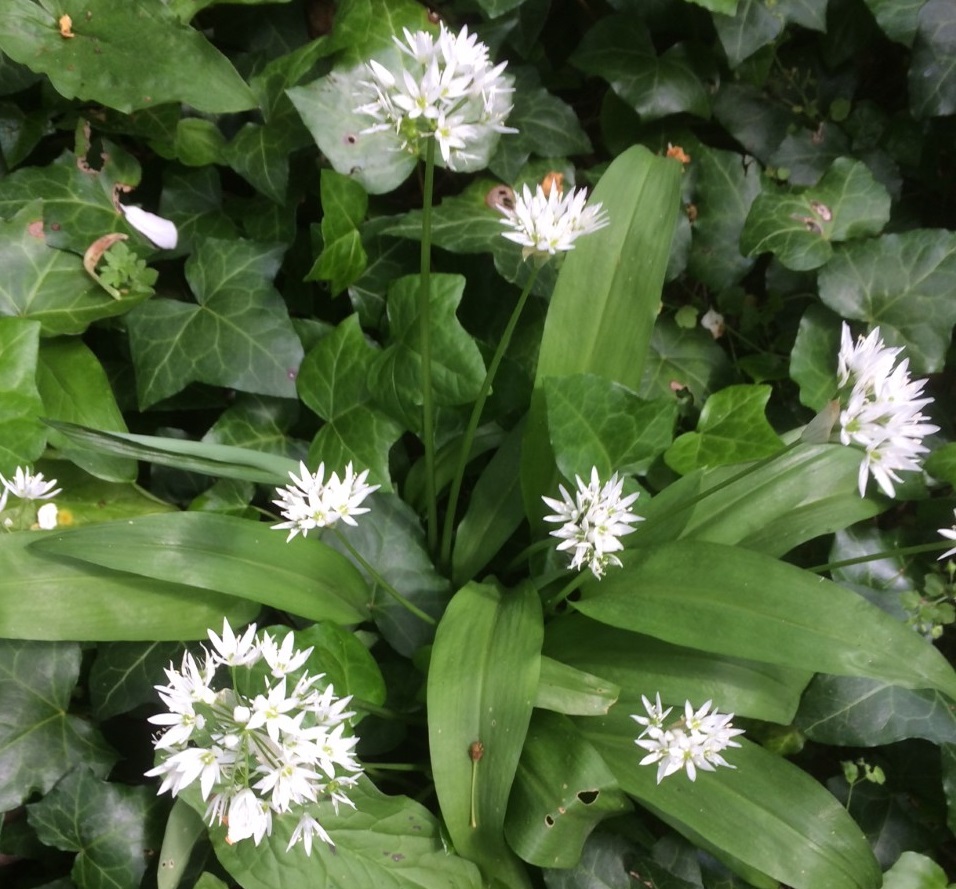
This is the very pretty wild relative of the onion and it flourishes in moist woodland which is why the Copse provides it with a good home.
It has long, strap-like, pointed leaves followed by umbels of white starry flowers. All parts of the plant are edible and are mildly garlic flavoured.
It is reckoned to be the sign of an ancient woodland and a good spring tonic!
Garlic Mustard (Alliaria petiolata)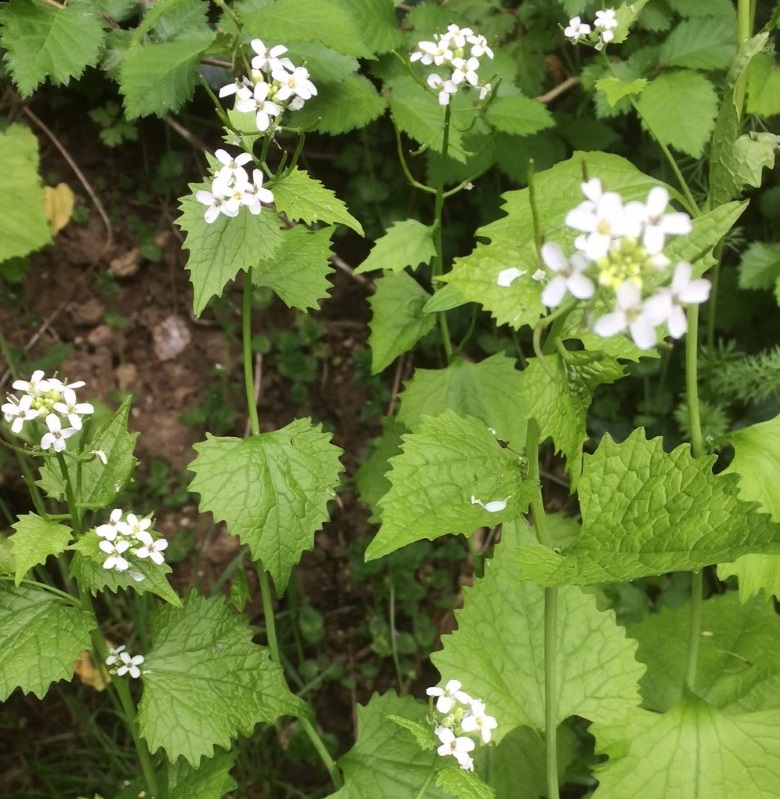
This tall, common hedgerow plant understandably had the old British name of Jack-by-the-hedge.
It can grow over a metre tall and has a cluster of small, white, cross-shaped flowers which puts it in the Cruciferae family.
The plant was used as far back as 4000 BC as a spice, and if you crush or taste the leaves they are mildly garlicky and can be used in salads.
MARCH 2020
List of 15 flowering plants recorded at the Community Woodland in March 2020:
Blackthorn (Prunus spinosa), Celandine (Ficaria verna), Cherry laurel (Prunus laurocerasus), Common speedwell (Veronica officinalis), Cowslip (Primula veris), Daisy (Bellis perennis), Dandelion (Taraxacum officinale), Euphorbia (Euphorbia amygdaloides robbiae), Greater stitchwort (Stellaria holostea), Ground ivy (Glechoma hederacea), Plum (Prunus domestica), Red deadnettle (Lamium purpureum), Viburnum (Viburnum tinus), Vinca (Vinca major), Wayfaring tree (Viburnum lantana),
Spring Flowers!
These are common, although not as common as they were, and are present at the Community Woodland.
Greater Stitchwort (Stellaria holostea) 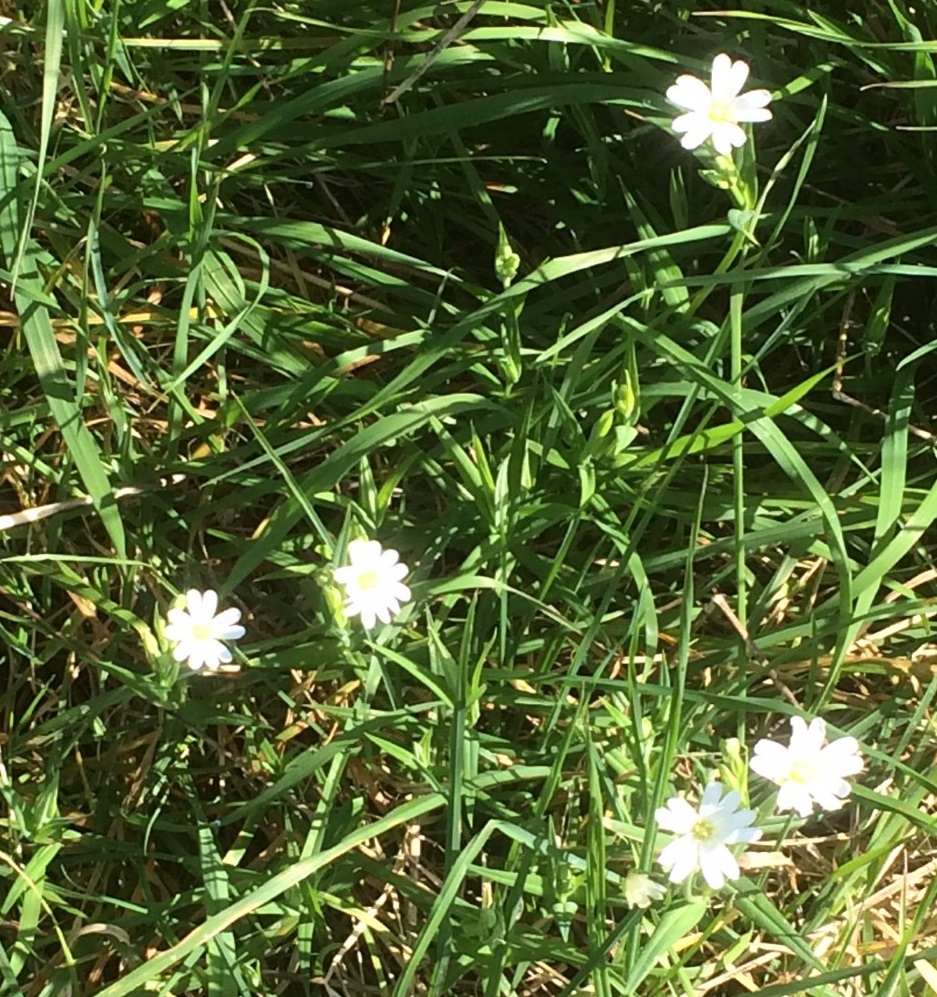
Understandably, they are also called Star of Bethlehem or Snapdragon because if you are there at just the right moment you can actually hear the seeds popping!
It was once gathered to make an infusion, a bit like tea, to take if you have a stitch in your side.
On the other hand, there was the belief that people who picked the flowers might be led away by pixies, so beware!
Cowslip (Primula veris) 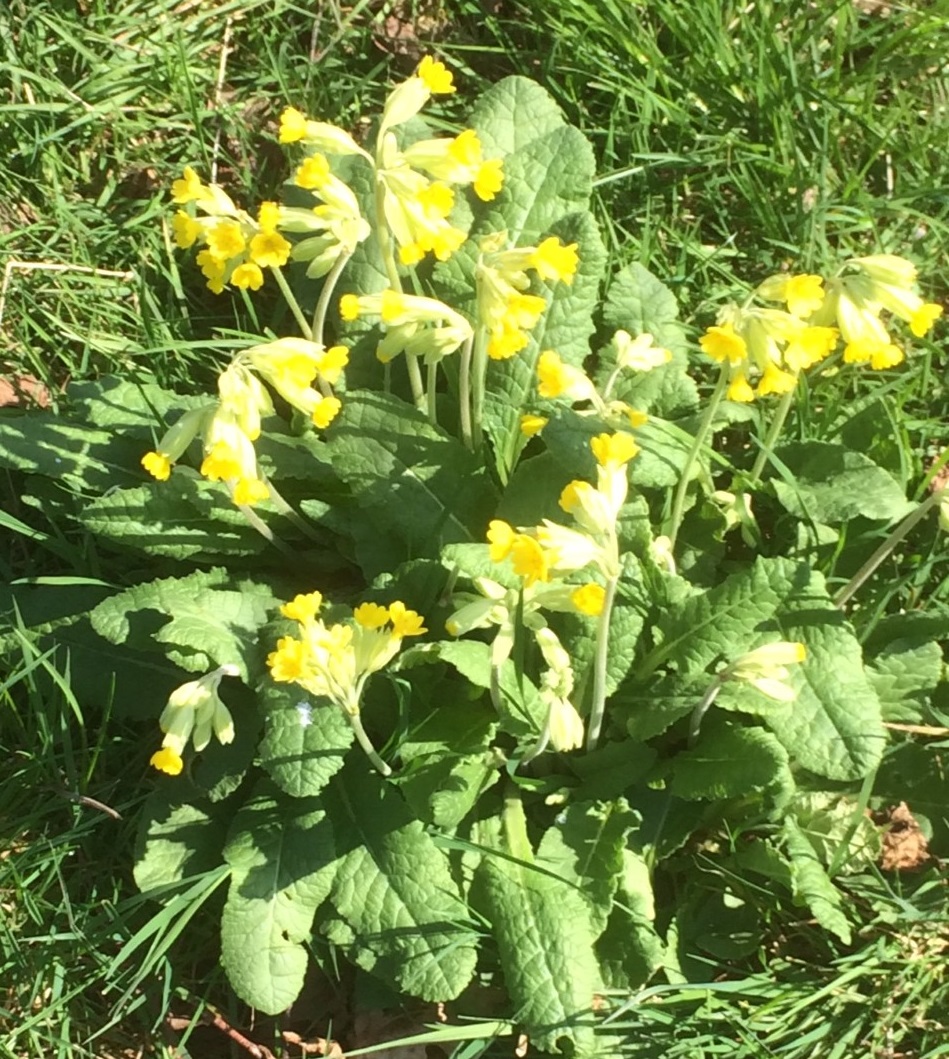
This is a much-loved perennial in the primrose family. The name may come from the Old English for cow dung as it was in cow pastures that they were often found.
It used to be a common wildflower but since the changes in agricultural practices in the 1970s and 1980s, it is becoming rarer.
We have several small but increasing clumps at the woodland.
Cowslip seeds are sometimes included in wild flower mixes used on motorway banks or in civil engineering projects. A lovely local example is along the A358 near Hatch Beauchamp where the banks are simply covered in cowslips!